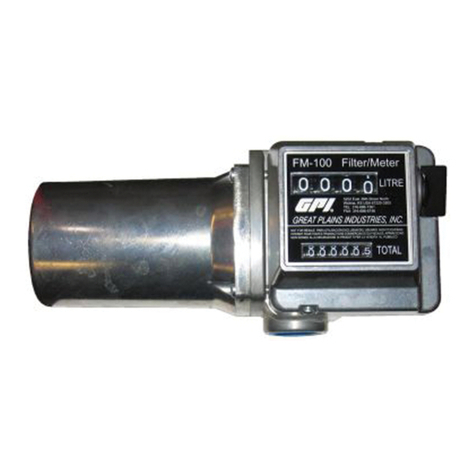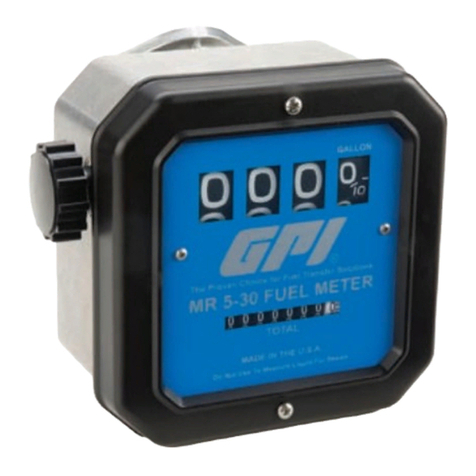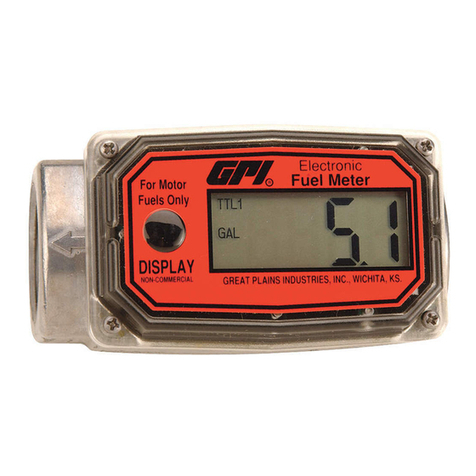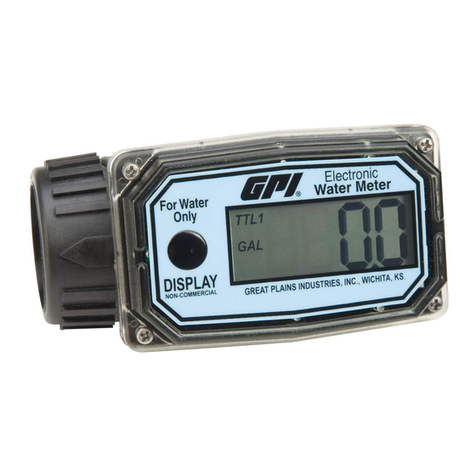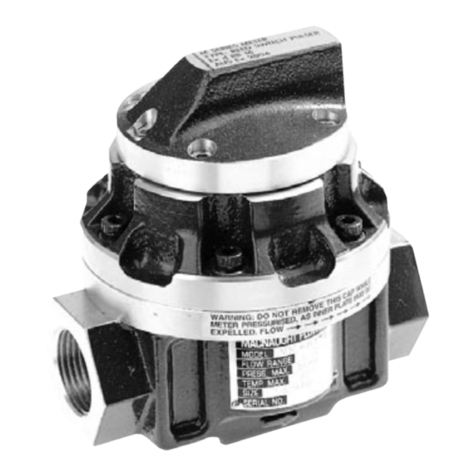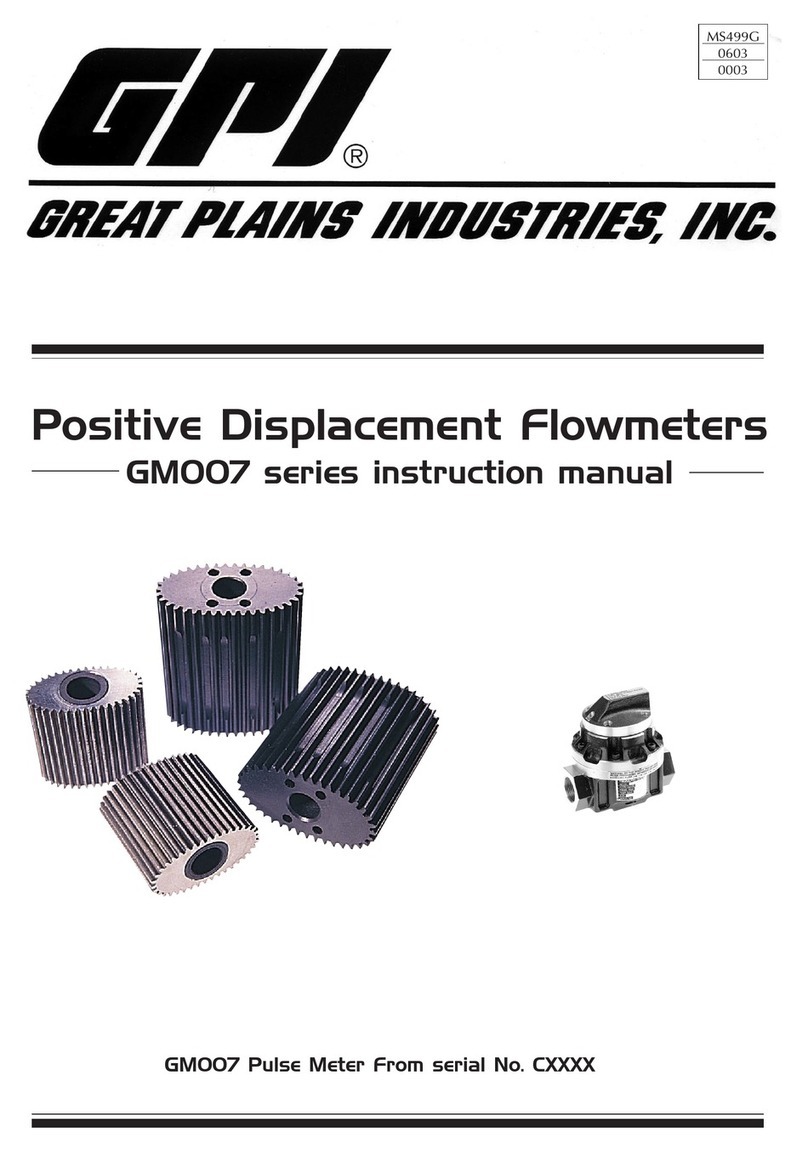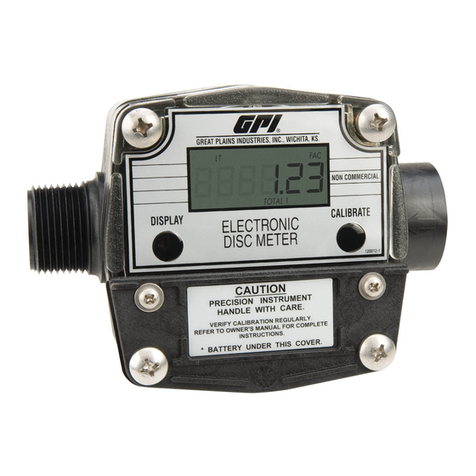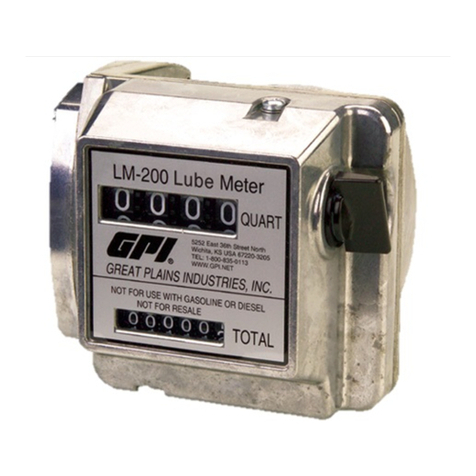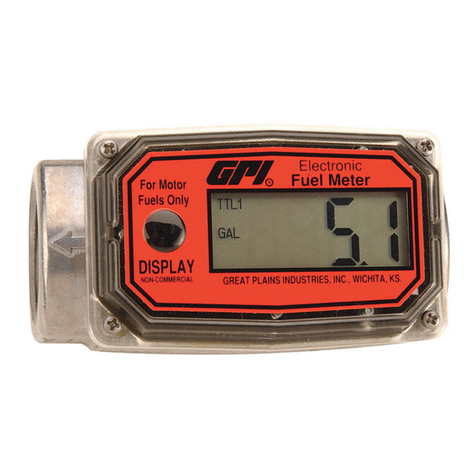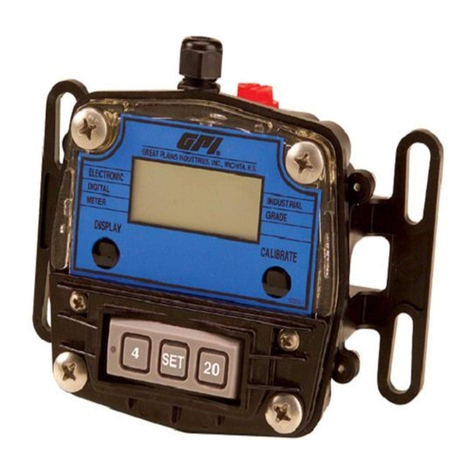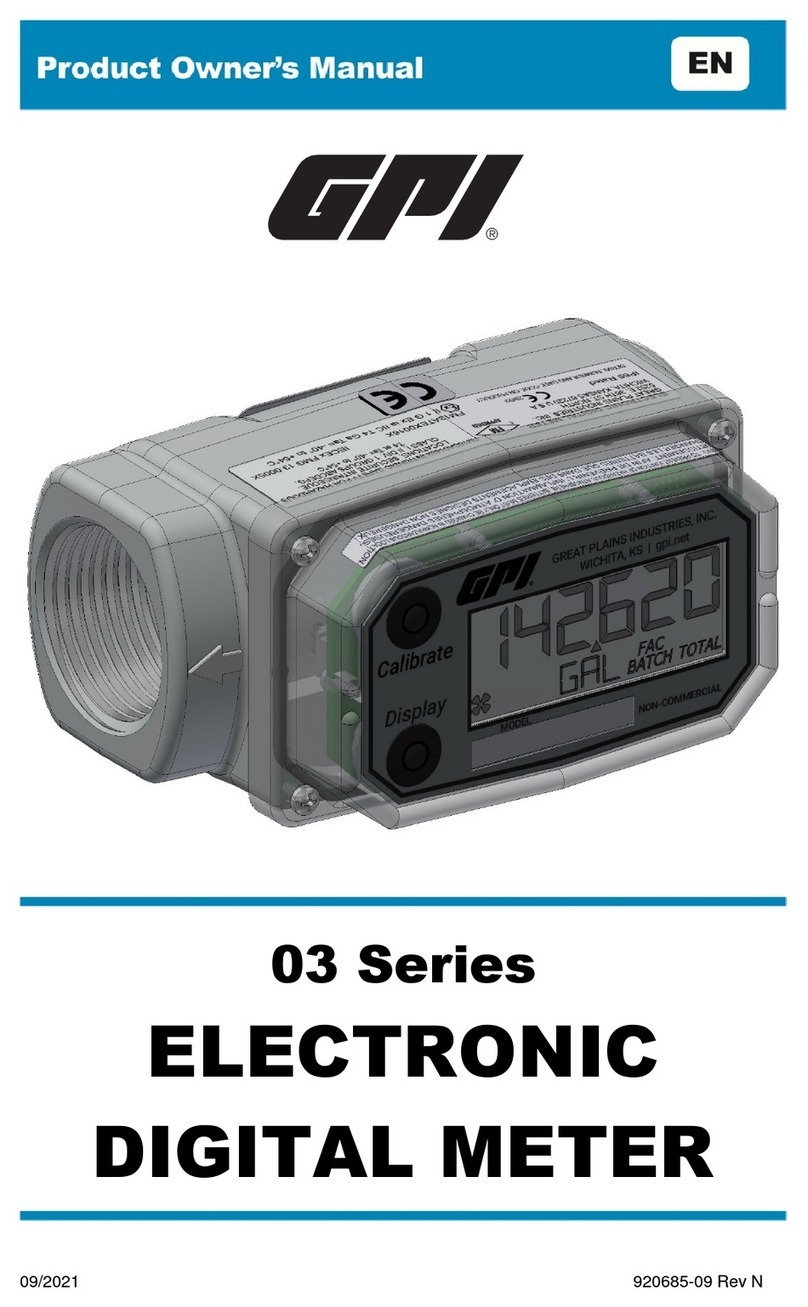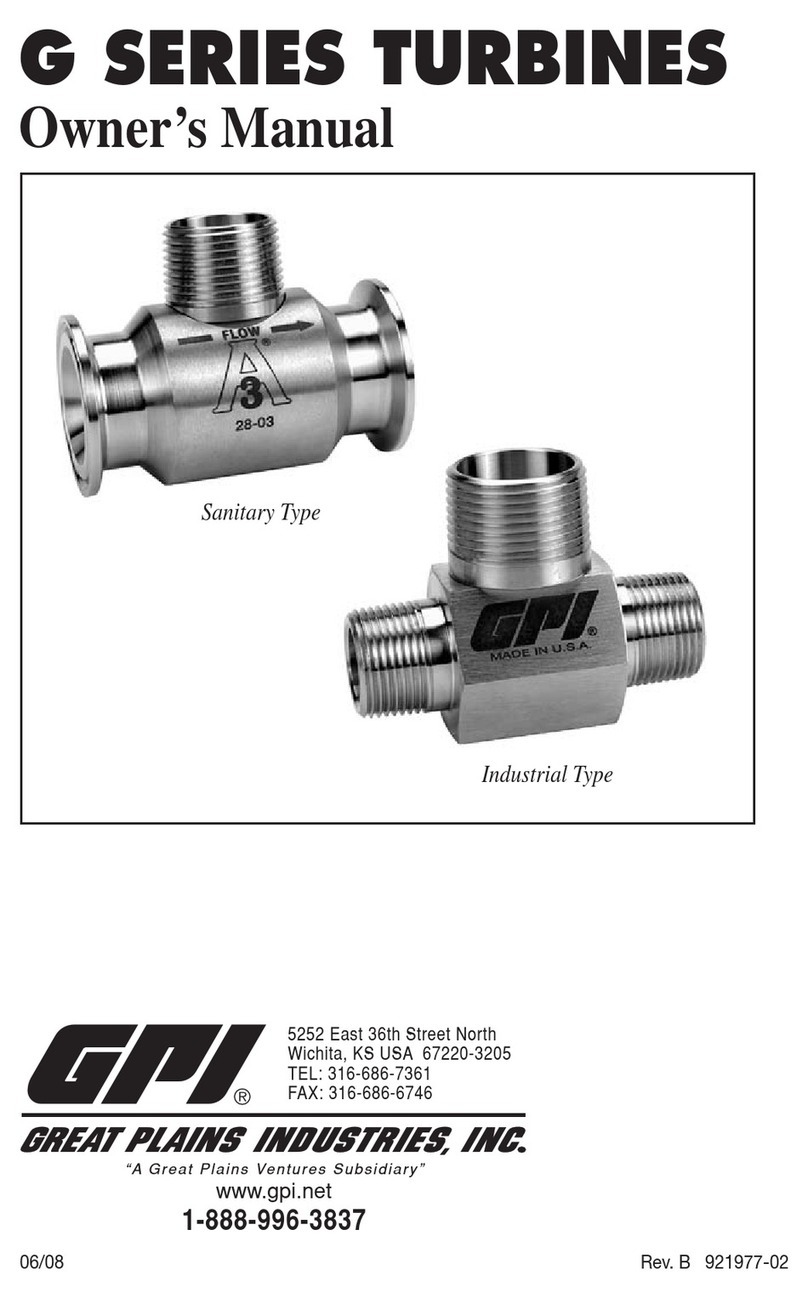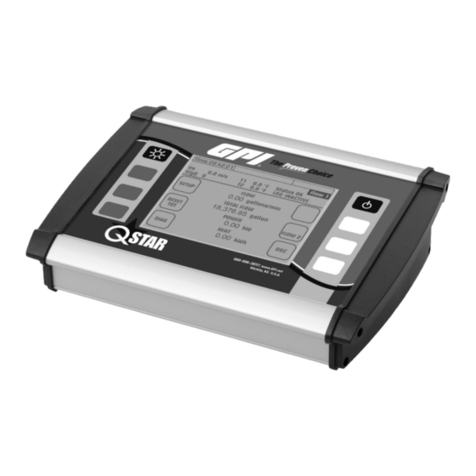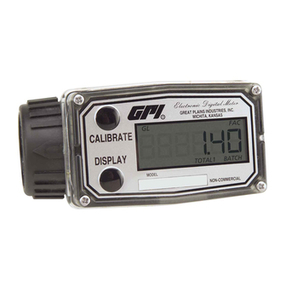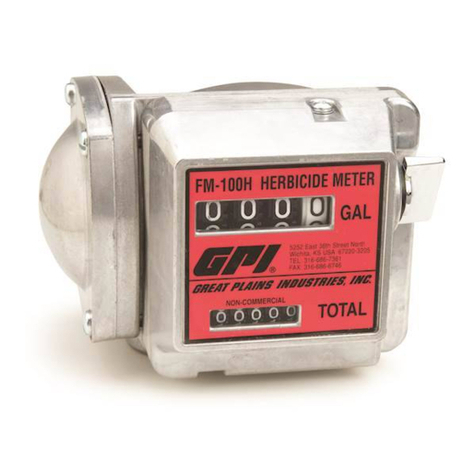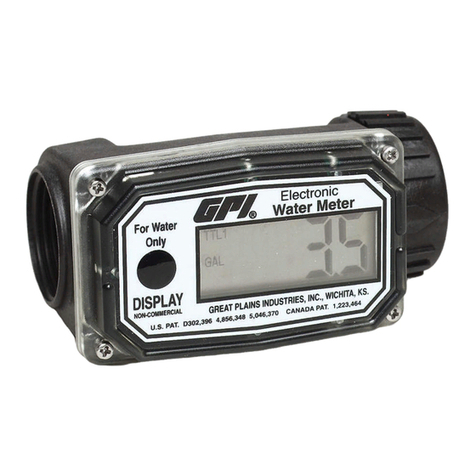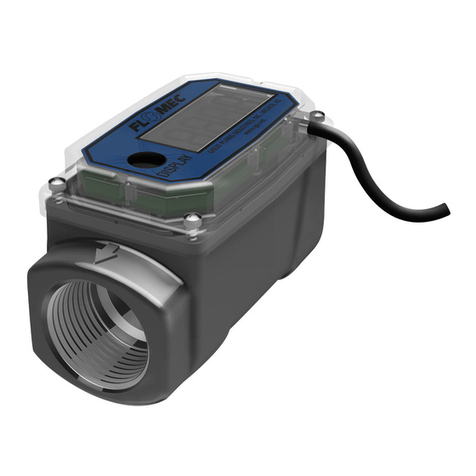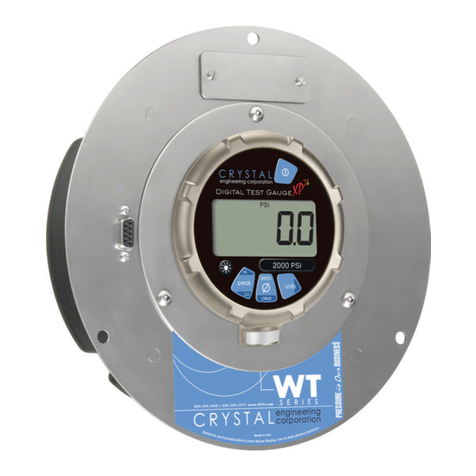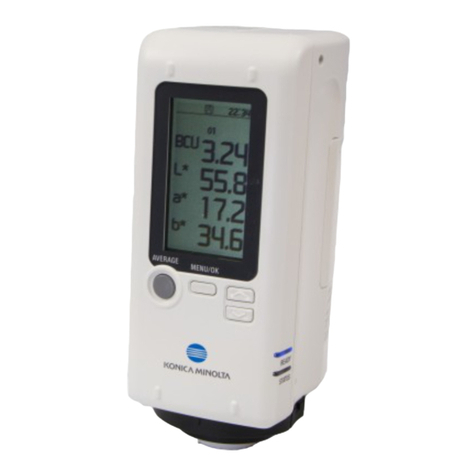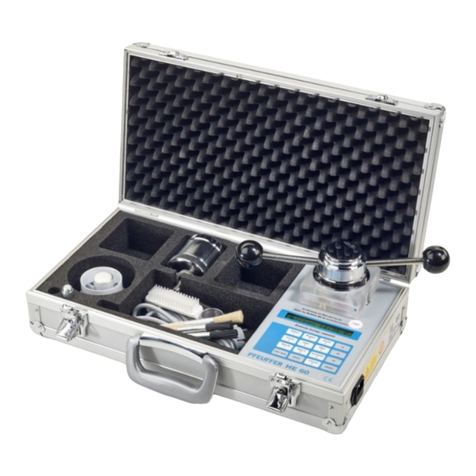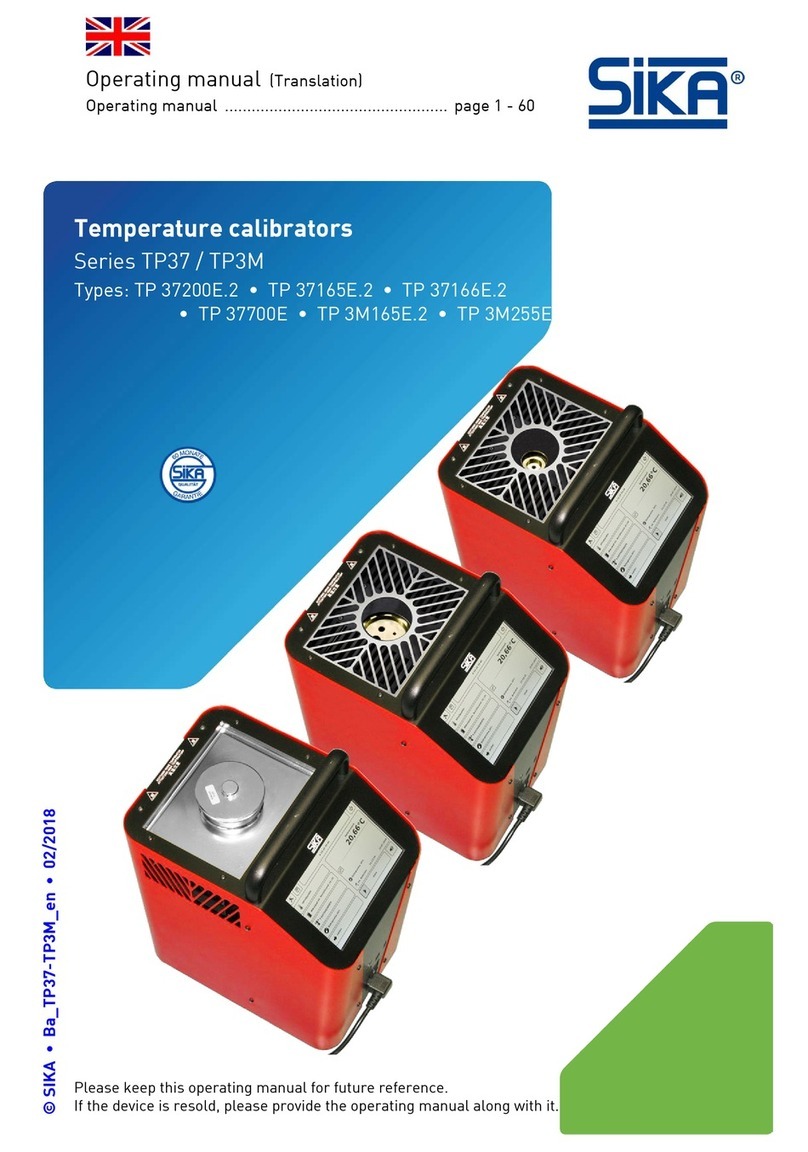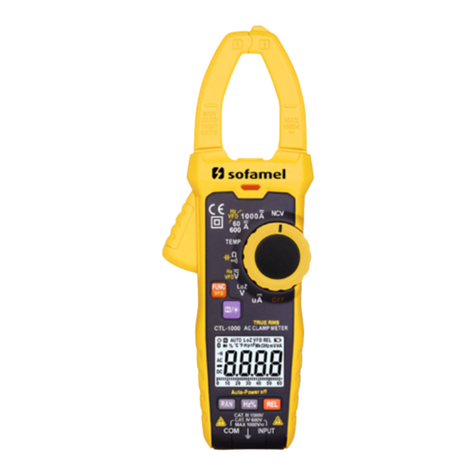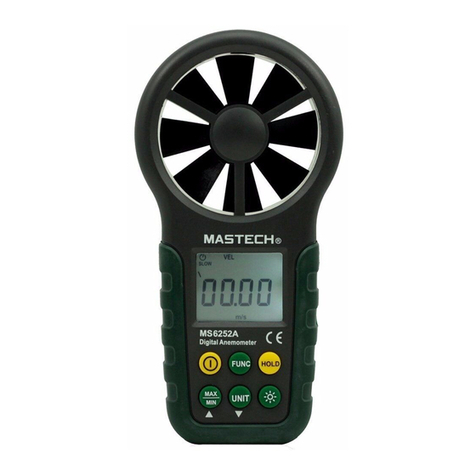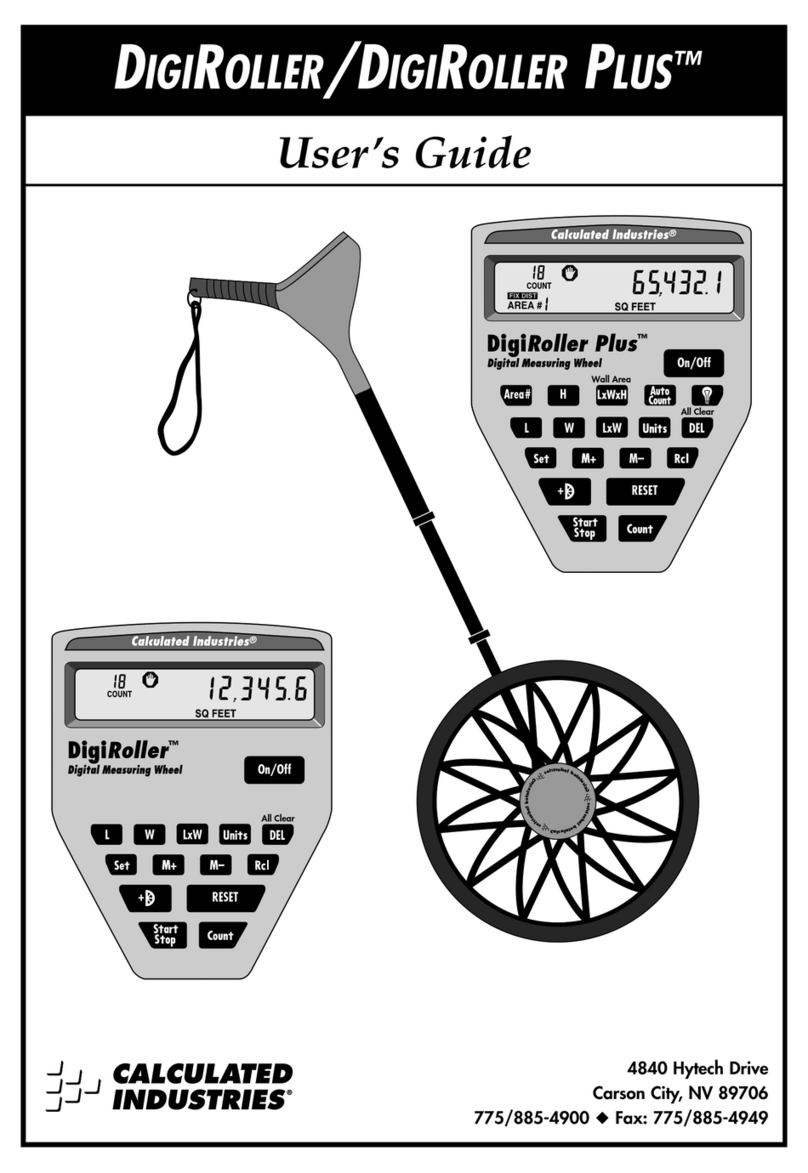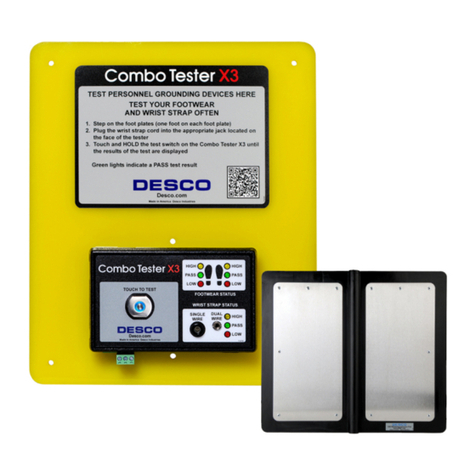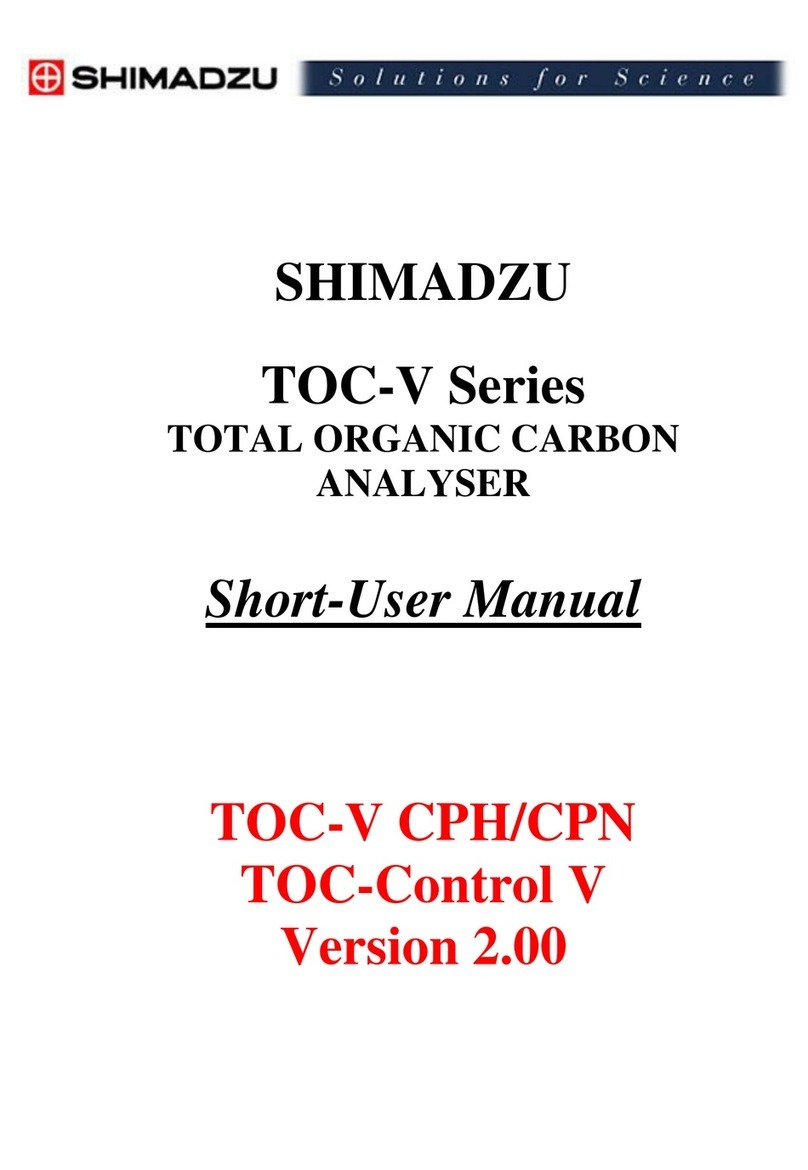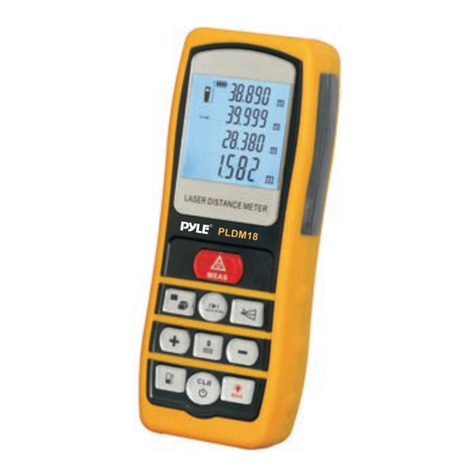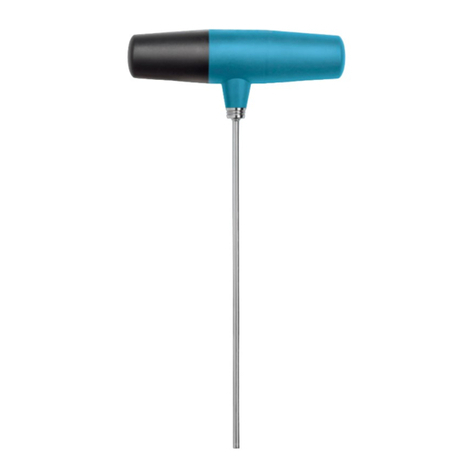GPI TM Series User manual

5252 East 36th Street North
Wichita, KS USA 67220-3205
TEL: 316-686-7361
FAX: 316-686-6746
“A Great Plains Ventures Subsidiary”
www.gpi.net
1-888-996-3837
Use TM Series meters with water and other
chemicalscompatiblewithwettedcomponents
(see Specifications Section). Do not use to
meter fuel or chemicals. TM Series meters
measure in gallons or litres. Refer to the Cali-
bration Section for details.
These meters are not legal for trade applica-
tions.
TM Series meters are very sensitive to electric
noise if operated within one to two inches of
some electric motors or other sources of elec-
tronic noise.
Install your meter in-line either horizontally or
vertically or at the end of the hose adjacent to
the nozzle. Installation to metal connections is
not recommended. Install as follows:
1. Plan to install turbine with a minimum
straight pipe length as follows:
–Upstreamfromtheturbine,allowamini-
mum straight pipe length of 10 times
the internal diameter of the turbine.
–Downstream from the turbine, allow a
minimum straight pipe length of 5 times
the internal diameter of the turbine.
2. For Soc Fittings use only primer and sol-
vents approved for PVC gluing.
For NPT Fittings wrap all connections with
3 to 4 wraps of Teflon
®
tape. Make sure the
tape does not intrude into the flow path.
3. Attach meter with arrow pointed in the
direction of flow.
4. ForNPTFittings- Hand tighten the meter at
the housing ends. Do no use a wrench or
similar tool to tighten. This can damage the
housing.
Verify Meter Accuracy
Before using, check the meter’s accuracy and
verify calibration.
1. Make sure there is no air in the system by
starting the flow until it runs steadily. Then,
stop the flow using a valve or nozzle.
2. If desired, hold down DISPLAY for 3 sec-
onds to zero the meter’s Batch Total. When
zeros appear, release the button.
3. Meter an exact known volume into an ac-
curate container. For best results, meter
with one continuous full stream.
Operations Guide for
TM Series Electronic Water Meters
1
Rev. B 920786-01
03/05
TABLE OF CONTENTS
English ......................................................... 1
Español ........................................................ 6
Deutsch ...................................................... 11
Italiano ....................................................... 17
Français ..................................................... 22
ENGLISH
IMPORTANT NOTICE
INSTALLATION
SAVE THESE INSTRUCTIONS

4. Check the readout. If the amount metered
is accurate, field calibration is not neces-
sary. If not, refer to the Calibration Section
for further instructions.
Batch and Cumulative Totals
The meter maintains two totals. The Cumula-
tive Total provides continuous measurement
and cannot be manually reset. The Batch Total
can be reset to measure flow during a single
use. The Cumulative Total is labeled with TO-
TAL 1 LOCKED indicating that this total is
locked and cannot be manually zeroed. Batch
Total is labeled with TOTAL 2.
When the Cumulative Total reaches a maxi-
mum reading of 999,999, it will automatically
reset to zero.
Press the DISPLAY button briefly to switch
between the batch, cumulative total, and
flowrate.
NOTE: Totalization counts total units without
differentiating between gallons, litres or
field calibrated units.
Flowrate Feature
When this feature is activated, the word FLOW-
RATE displays to the left on the bottom line.
When FLOWRATE is displayed, the numbers
on the middle line reflect the rate of flow, for
example, the current gallons per minute (GPM)
or litres per minute (LPM).
Display FLOWRATE
To use this feature, press and release DISPLAY
until FLOWRATE appears to the left of the
bottom line.
Activate the Meter
Turn the meter ON by starting water flow or
briefly pressing the DISPLAY button. The meter
will display the Batch or Cumulative Total from
last use.
Press DISPLAY briefly to display the Batch
Total. Hold the DISPLAY button down for 3
seconds to reset the Batch Total to zero.
The meter is programmed to turn off auto-
matically if not used for 4 minutes.
FactoryandFieldCalibrationCurves
All calibration information is visible to the user
as words in the upper part of the display, above
the numeric digits.
All units are configured with a “factory” calibra-
tion curve. Both gallons and litres are available
(“GAL” or “LTR” will be displayed). Use the
CALIBRATE and DISPLAY buttons to switch
between gallons and litres. This curve is NOT
user adjustable: the word “PRESET” is dis-
played to show this. (The factory calibration is
storedpermanentlyinthecomputer’smemory.)
The “field” calibration curve may be set by the
user, and can be changed or modified at any
time using the calibration procedure described
below in the Calibration Section. Totals or
flowrate derived from the field calibration are
visible when the field calibration setting is se-
lected (“CAL B” will be visible on the top line).
Selecting a Different
Calibration Setting
You can switch between GAL and LTR modes
at will without “corrupting” totalizer contents.
For example, the computer can totalize 10.00
gallons. If the user switches to LTR mode, the
display will immediately change to “37.50” (the
same amount in units of litres). GAL / LTR
switching also works in FLOWRATE mode.
To select a different calibration setting, first
press and hold the CALIBRATE button. Con-
tinue to hold it while also pressing and releasing
the DISPLAY button. (You may then also re-
lease the CALIBRATE button.) The flag indica-
tors in the top line of the display will change to
show the newly selected calibration setting.
Calibration settings change in this order: GAL,
LTR, CAL B, GAL, etc. While fluid is flowing,
only the GAL and LTR selections may be made.
However, when NO fluid flow is occurring, any
setting may be selected.
Field Calibration
Factory calibration settings are custom-pro-
grammed into each flowmeter during produc-
tion, using water at 70°F (21°C). Readings us-
ing the standard factory calibration curves may
not be accurate in some situations – for ex-
ample, under extreme temperature conditions.
OPERATION
2

You can field calibrate the meter if you are using
fluids other than water.
For improved accuracy under such conditions,
the GPI flow computer allows for “field” calibra-
tion, that is, user entry of custom calibration
parameters. A “single point” calibration may
yield acceptable accuracy in the middle of the
flow range, but 5 or more calibration points may
yield a higher level of accuracy, especially at
the lower end of the flow range. Up to 15
custom calibration points can be entered.
The use of a uniformly dependable, accurate
calibration container is highly recommended
for the most accurate results. Due to high
flowrate, it is strongly recommended that Field
Calibrationbe completed with acombinationof
volume and weight using fine resolution scales.
Before Beginning Field Calibration
For the most accurate results, dispense at a
flowrate which best simulates your actual oper-
atingconditions. Avoid “dribbling” morefluidor
repeatedly starting and stopping the flow –
theseactions will result inlessaccurate calibra-
tions.
Make sure you meet the meter’s minimum
flowrate requirements:
TM Series Meters
1/2 inch meter 1 GPM (3.8 LPM)
3/4 inch meter 2 GPM (7.5 LPM)
1 inch meter 5 GPM (18.8 LPM)
1-1/2 inch meter 10 GPM (37.5 LPM)
2 inch meter 20 GPM (75 LPM)
For best results, the meter should be installed
and purged of air before field calibration.
Dispense/Display Field
Calibration Procedures
1. Hold down CALIBRATE while pressing and
releasing DISPLAY until the field calibra-
tion curve appears (“CAL B” message will
be displayed). Release both buttons.
2. To calibrate, press and hold the CALI-
BRATE button. While continuing to hold
CALIBRATE, also press and hold the DIS-
PLAY button. Hold both buttons for about
3seconds until you see ablinking “ddCAL”
message. Once the “dd CAL” message
appears, release both buttons. You are
now in field calibration mode.
3. Once the buttons have been released from
Step 2, the display will show the blinking
message “run 01”. If you want to exit the
calibrationnowbeforedispensinganyfluid,
go to Step 11.
4. If you want to continue with the calibration,
but have not dispensed any fluid yet, make
your final preparations to your pumping
system, but don’t start pumping yet.
5. Start your pumping system so that fluid
flows through the meter. The display will
stop blinking and show the “run 01” mes-
sage. Dispense into a container that allows
you to judge the amount of fluid pumped.
Whenyouhave pumpedthedesiredamount
(for example, 10 gallons), stop the fluid flow
quickly.
6. Once the flow has stopped, briefly press
and release both buttons. At this point the
computer display will change to “0000.00”
with the left-hand digit blinking.
7. Enter the volume (amount) of fluid that you
dispensed (for example, if your 10-gallon
container is full, enter “10.0” for gallons or
“37.5” for litres). To enter numbers, use the
CALIBRATE button to change the value of
the digit that is blinking and use the DIS-
PLAY button to shift the “blink” to the next
digit.
8. Once the correct number is entered, briefly
press and release both buttons. The dis-
play will now change to a blinking “run 02”
message. You have installed the new cal-
curve point. You are ready to end calibra-
tion (Step 10) or enter another new calibra-
tion point (Step 9).
9. To enter another calibration point, go back
and repeat Steps 3 through 8. It is possible
to set up to 15 cal-curve points, and the
“run ##” message will increment each time
you repeat the calibration process (run 01,
run 02, run 03, etc., up to run 15).
10. To end calibration, press and hold both
buttons for about 3 seconds until you see
the “CAL End” message. After you release
the buttons the computer will resume nor-
mal operations with the new cal point(s)
active.
3

11. If you HAVE NOT dispensed any fluid, you
can exit calibration without changing the
cal curve. If the message “run 01” is show-
ing and you have not dispensed any fluid,
hold both buttons for about 3 seconds until
you see a “CAL End” message. After you
release the buttons, the computer will re-
sume normal operation and the old curve (if
you entered one in the past) is still intact.
Proper handling and care will extend the life
and service of the meter.
Turbine Rotor
The meter is virtually maintenance-free. How-
ever, it is important the rotor moves freely.
Keep the meter clean and free of contaminants.
If the rotor does not turn freely, apply a pen-
etrating lubricant on the rotor, shaft, and bear-
ings. Remove any debris or deposits from the
rotor using a soft brush or small probe. Be care-
ful not to damage the turbine rotor or supports.
Blowing compressed air through the tur-
bine assembly could damage the rotor.
Battery Replacement
The meter is powered by two 3-volt lithium
batteries which may be replaced while the
meter is installed. When batteries are removed
or lose power, the batch and cumulative totals
reset to zero but the field and factory calibra-
tions are retained.
If the meter display becomes dim or blank,
replace the batteries as follows:
1. RemovethefourPhillips-head screws from
the face of the meter and lift the faceplate
from the turbine.
2. Remove the old batteries and clean any
corrosion from the terminals.
3. Install new batteries. Make sure the posi-
tive post is in the correct position.
4. When the batteries are replaced, the face-
plate will power ON. Check the display to
ensure normal functions have resumed
before assembling again.
SPECIFICATIONS
4
MAINTENANCE
! ! ! CAUTION ! ! !
5. Reseat batteries, if necessary, and posi-
tion the faceplate on the turbine housing.
To avoid moisture damage, make sure the
O-ring is fully seated. Tighten the four
screws on the faceplate.
Inlet and Outlet:
TM050 1/2" Schedule 40, Soc
TM075 3/4" Schedule 40, Soc
TM100 1" Schedule 40, Soc
TM150 1-1/2" Schedule 40, Soc
TM200 2" Schedule 40, Soc
TM050-N 1/2" NPT
TM075-N 3/4" NPT
TM100-N 1" NPT
TM150-N 1-1/2" NPT
TM200-N 2" NPT
Design Type: Turbine
Wetted Components:
Housing: PVC
Journal Bearings: Ceramic
Shaft: Tungsten Carbide
Rotor and Supports: PVDF
Retaining Washer: Stainless Steel
Fitting Types: Slip - Schedule 40 Soc or NPT
Max. Working Pressure: 150 PSIG @ 73°F
U.S. Measurement
Unit of Measure: Gallon
Flow Range:
1/2 inch 1 - 10 GPM
3/4 inch 2 - 20 GPM
1 inch 5 - 50 GPM
1-1/2 inch 10 - 100 GPM
2 inch 20 - 200 GPM
Accuracy: ±3.0% (Accuracy can be
improved with field calibration)
Operating Temperature:*+32°to +140°F
Storage Temperature: –40°to +158°F
Product Weight:
1/2 inch .31 lbs.
3/4 inch .38 lbs.
1 inch .51 lbs.
1-1/2 inch .81 lbs.
2 inch 1.14 lbs.
*Do not allow fluid to freeze inside meter.

5
SERVICE
! ! ! CAUTION ! ! !
PARTS
Dimensions - inches (W x H x L):
1/2 inch 2 x 2.5 x 4.3
3/4 inch 2 x 2.7 x 5.3
1 inch 2 x 3 x 6
1-1/2 inch 2.3 x 3.6 x 7
2 inch 2.8 x 4.1 x 7.5
Metric Measurement
Unit of Measure: Litre
Flow Range:
1/2 inch 3.8 - 38 LPM
3/4 inch 7.6 - 76 LPM
1 inch 19 - 190 LPM
1-1/2 inch 38 - 380 LPM
2 inch 76 - 760 LPM
Accuracy: ±3.0% (Accuracy can be
improved with field calibration)
Operating Temperature:*0°to +60°C
Storage Temperature: –40°to +70°C
Product Weight:
1/2 inch .141 kg
3/4 inch .173 kg
1 inch .232 kg
1-1/2 inch .368 kg
2 inch .518 kg
Dimensions - cm (W x H x L):
1/2 inch 5.1 x 6.4 x 10.9
3/4 inch 5.1 x 6.9 x 13.5
1 inch 5.1 x 7.6 x 15.2
1-1/2 inch 5.8 x 9.1 x 17.8
2 inch 7.1 x 10.4 x 19.1
*Do not allow fluid to freeze inside meter.
For warranty consideration, contact your local
distributor. If you need further assistance, con-
tact the GPI Customer Service Department at:
1-800-835-0113
You will need to:
•Provide information from the decal on your
meter.
• Receive a Return Authorization number.
•Flush any fluid from the meter before ship-
ping to the factory.
•If possible leave customer installed fittings
or ample length of bare pipe for reinstalla-
tion.
Do not return the meter without specific
authority from the GPI Customer Service
Department. Due to strict regulations gov-
erningtransportation,handling,anddisposal
of hazardous or flammable liquids, GPI will
not accept meters for rework unless they
are completely free of liquid residue.
The following replacement parts and acces-
sories are available for the TM Series meters:
Part No. Description
113520-1 Battery Replacement Kit
116001-1 Calibration Container, Large (5 gallon)
901002-52 O-Ring
125508-01 1/2 inch, Soc Turbine Assy Kit
125508-02 1/2 inch NPT, PVC Turbine Assy Kit
125510-01 3/4 inch, Soc Turbine Assy Kit
125510-02 3/4 inch NPT, PVC Turbine Assy Kit
125512-01 1 inch, Soc Turbine Assy Kit
125512-02 1 inch NPT, PVC Turbine Assy Kit
125514-01 1-1/2 inch, Soc Turbine Assy Kit
125514-02 1-1/2 inch NPT, PVC Turbine Assy Kit
125516-01 2 inch, Soc Turbine Assy Kit
125516-02 2 inch NPT, PVC Turbine Assy Kit
Computer Kits:
125509-01 1/2 inch, Computer Assy Kit
125511-01 3/4 inch, Computer Assy Kit
125513-01 1 inch, Computer Assy Kit
125515-01 1-1/2 inch, Computer Assy Kit
125517-01 2 inch, Computer Assy Kit

6
E S P A Ñ O L
AVISO IMPORTANTE
Utilizar los metros de los Series del TM con agua
y otros productos químicos que son compati-
bles con les componentes que se exponen al
líquido (véase la sección de especificaciones).
No utilizar para medir el combustible o los
productos químicos. Los medidores Series TM
miden en galones o litros. Referirse a la sección
de la calibración para mayores detalles.
Estos medidores no son legales para las
aplicaciones comerciales.
Los medidores de las Series TM son muy sen-
sibles a interferencia electrónica si funcionan
a 1 o 2 pulgadas de algunos motores eléctri-
cos o de otras fuentes del uso electrónico.
Instalar su medidor en línea, u horizontalmente,
o verticalmente, o en el extremo de la manguera
adyacente al inyector. No se recomienda la
instalación a las conexiones de metal. Siga
estos pasos para instalar:
1. Planee instalar la turbina con una longitud
mínima de la pipa recta de esta manera:
–Contra la corriente de la turbina,
permita a una longitud mínima de la
pipa recta de 10 veces el diámetro
interno de la turbina.
–Con la corriente de la turbina, permita
una longitud mínima de la pipa recta de 5
veces el diámetro interno de la turbina.
2. Para Las Conexiones Del Soc utilizar
solamente los solventes aprobados para
pegar PVC.
Para Las Conexiones Del NPT cubrir las
conexiones de pipa con la cinta del Teflon
®
3 a 4 veces. Cerciorarse de que la cinta
no imponga en la trayectoria del flujo.
3. Unir el metro con la flecha señalada en la
dirección del flujo.
4. Para Las Conexiones Del NPT utilizar
solamente sus manos para apretar las
conexiones del metro. No utilizar una llave
inglesa o una herramienta similar para
apretar. Esto puede dañar la cubierta.
INSTALACIÓN
Verificar La Exactitud Del Metro
Antes de usar, comprobar la exactitud del metro
y verificar la calibración.
1. Cerciorarse de que no haya aire en el sis-
tema comenzando el flujo hasta que func-
iona constantemente. Entonces, detenga
el flujo usando una válvula o un inyector.
2. Si desea, mantenga el botón de la
EXHIBICIÓN durante 3 segundos para
llevar a cero el total de medidor. Cuando
aparezcan los ceros, suelte el botón.
3. Con el medidor, mida un volumen exacto
en un envase exacto. Para mejores
resultados, medir con una corriente com-
plete y continua.
4. Comprobar la lectura. Si la cantidad
medida es exacta, la calibración de
campo no es necesaria. Si no, refeierase
a la sección de la calibración.
Hornada y Totales Acumulativos
El medidor mantiene dos totales. El total acu-
mulativo proporciona la medida continua y no
puede ser reajustado manualmente. El total de
hornada se puede reajustar para medir el flujo
durante una sola vez . El total acumulativo se
etiqueta con el TOTAL 1 LOCKED. Esto indica
que el total esta bloqueado y no puede ser
puesto a cero manualmente. El total de hornada
se etiqueta con el TOTAL 2.
Cuando el total acumulativo alcanza una lectura
máxima de 999.999, se reajustará automática-
mente a cero.
Presionar el botón de DISPLAY brevemente
para cambiar entre la hornada, el total acumu-
lativo, y el índice de flujo.
NOTA: Totalization cuenta las unidades totales
sin distinguir entre los galones, los litros
o las unidades calibradas de campo.
Característica Del Índice De Flujo
Cuando se activa esta característica, aparece
la palabra FLOWRATE a la izquierda hasta
abajo.
OPERACIÓN

7
Cuando se exhibe el FLOWRATE, los números
en la línea media reflejan el régimen, por
ejemplo, los galones actuales por minuto (GPM)
o los litros por minuto (LPM).
ExhibiciónDel Índice De Flujo
Para utilizar esta característica, presionar y
soltar el botón del DISPLAY hasta que
FLOWRATE aparece a la izquierda hasta abajo.
Activar El Metro
Encienda el metro comenzando el flujo del agua
o brevemente presionando el botón del DIS-
PLAY. El medidor exhibirá la hornada o el total
acumulativo a partir de la última vez que fue
utilizado.
Presionar el botón del DISPLAY brevemente
para exhibir el total de hornada. Oprima el
botón de DISPLAY por 3 segundos para
reajustar el total de hornada a cero.
El medidor se apaga automáticamente si no
es usado durante 4 minutos.
Curvas De Calibración De La
Fábrica y Del Campo
Toda la información de la calibración es visible
al usuario como palabras en la parte superior
de la exhibición, sobre los dígitos numéricos.
Todas las unidades se configuran con una
curva de calibración de la “fábrica”. Los gal-
ones y los litros están disponibles. (el “GAL” o
el “LTR” será visible). Utilizar los botones del
CALIBRATE y del DISPLAY para cambiar entre
los galones y los litros. Esta curva de calibra-
ción no es ajustable por el usuario. La palabra
PRESET se exhibe para demostrar esto. (La
calibración de la fábrica se almacena perma-
nentemente en la memoria de computadora.)
La curva de calibración de “campo” se puede
fijar por el usuario. La calibración se puede
cambiar o modificar en cualquier momento
usando los procedimientos de la calibración
descritos en la sección de la calibración. Los
totales o el índice de flujo derivados de la
calibración de campo son visibles cuando se
selecciona el ajuste de la calibración de campo
(la “CAL B” será visible en la línea superior).
Seleccionar Un Ajuste
Diverso De La Calibración
Usted puede cambiar entre los modos del GAL
y del LTR a voluntad sin afectar los totales. Por
ejemplo, la computadora puede sumar 10,00
galones. Si el usuario cambia al modo del LTR,
la exhibición cambiará inmediatamente a
“37,50” (la misma cantidad en las unidades de
los litros). La conmutación del GAL/LTR
también trabaja en el modo del FLOWRATE.
Para seleccionar un ajuste diverso de la calibra-
ción, oprima y sostenga el botón de la CALI-
BRATE. Continuar sosteniendo el botón
mientras que también presiona y suelta el botón
de DISPLAY. (usted puede entonces también
soltar el botón de la CALIBRATE.) Los indi-
cadores de la bandera de la línea superior de
la exhibición cambiarán para demostrar el
nuevo ajuste seleccionado de la calibración.
Los ajustes de la calibración se cambian en
este orden: GAL, LTR, CAL B, GAL, etc.
Mientras que está fluyendo el líquido, sólo las
selecciones del galón y del litro pueden ser
hechas. Sin embargo, cuando no está fluyendo
NINGÚN líquido, cualquier selección puede ser
hecha.
Calibración Del Campo
Los ajustes de la calibración de la fábrica se
programan especificamente en cada flujó-
medidor durante su producción usando agua
a 70°F (21°C). Las lecturas que utilizan las
curvas de calibración estándares de la fábrica
pueden no ser exactas en algunas situaciones.
Por ejemplo, cuando se encuentran bajo condi-
ciones de temperatura extremas. Usted puede
campo calibrar el metro si usted está utilizando
los líquidos con excepción del agua.
Para la exactitud mejorada bajo tales condi-
ciones, la computadora GPI de flujo tienen en
cuenta la calibración del “campo” (es decir un
apunte del usuario dentro de los parámetros
de calibración especiales). La calibración de
“un solo punto” puede rendir una exactitud
aceptable en medio de la gama del flujo. Cinco
o más puntos de calibración pueden rendir un
nivel más alto de exactitud, especialmente en
el extremo inferior de la gama del flujo. Hasta
15 puntos de calibración especiales pueden
ser incorporados.

8
Se recomienda altamente usar un envase
confiable, y exacto para la calibración. Para
obtener resultados más exactos. debido al alto
índice de flujo, se recomienda fuertemente que
la calibración de campo esté determinada con
una combinación del volumen y del peso
usando las escalas de alta resolución.
Antes De Comenzar La
Calibración De Campo
Para resultados más exactos, dispense un
índice de flujo que simule lo mejor posible sus
condiciones de funcionamiento reales. Evite
“de gotear “ más líquido o en varias ocasiones,
o el comenzar y de parar el flujo. Estas acciones
darán lcomo resultado calibraciones menos
exactas.
Cerciorese de reunir todos los requisitos míni-
mos del índice de flujo del medidor:
Medidores de las Series del TM
Medidor de 1/2 pulgada de
1 GPM (3,8 LPM)
Medidor de 3/4 pulgada de
2 GPM (7,5 LPM)
Medidor de 1 pulgada de
5 GPM (18,8 LPM)
Medidor de 1-1/2 pulgadas de
10 GPM (37,5 LPM)
Medidor de 2 pulgadas de
20 GPM (75 LPM)
Para mejores resultados, el medidor se debe
instalar y purgar del aire antes de la calibración
de campo.
Procedimientos De la Calibración
De Campo De Dispense/Display
1. Mantener oprimido el botón del CALI-
BRATE mientras que presionar y suelta el
boton DISPLAY hasta que aparece la
curva de calibración de campo (mensaje
de “CAL B” será exhibido). Suelte ambos
botones.
2. Para calibrar, presionar y sostener el botón
del CALIBRATE. Mientras que continúa
oprimiendo el CALIBRATE, también
presionar y sostener el botón del DISPLAY.
Sostener ambos botones por cerca de 3
segundos hasta que usted vea el mensaje
de “dd-CAL” en centelleo. Una vez que
mensaje del “dd-CAL”, aparezca, suelte
ambos botones. Usted ahora está en el
modo de la calibración de campo.
3. Una vez que los botones se hayan soltado
(el paso 2), la exhibición demostrará el
mensaje del centelleo “RUN 01”. Si usted
desea salir del proceso de la calibración
antes de dispensar cualquier líquido, ir al
paso 11.
4. Si usted desea continuar con la calibra-
ción, pero no ha dispensado ningún
líquido todavía, hacer las preparaciones
finales a su sistema de bombeo, pero no
comenzar a bombear todavía
5. Comience su sistema de bombeo de
modo que el líquido atraviese el metro.
La exhibición parará el centelleo y demo-
strará el mensaje del “ RUN 01”. Dispense
el líquido en un envase que permita que
usted juzgue la cantidad de líquido
bombeada. Cuando usted ha bombeado
la cantidad deseada (por ejemplo, 10
galones), detenga el flujo fdel liquido
inmediatamente.
6. El flujo ha parado; brevemente presione y
suelte una vez ambos botones. En este
momento la exhibición de la computadora
cambiará al “0000.00” con el centelleo a
la izquierda del dígito.
7. Introduzca el volumen (cantidad) de
líquido que usted ha dispensado (por
ejemplo, si su envase de los 10-gallon es
lleno, introducir “10,0” para los galones o
“37,5” para los litros). Para incorporar los
números, utilizar el botón del CALIBRATE
para cambiar el valor del dígito que está
en centelleo. Utilizar el botón del DISPLAY
para cambiar de puesto el “centelleo” al
dígito siguiente.
8. Una vez que se incorpore el número
correcto, presionar y soltar brevemente
ambos botones. La exhibición ahora
cambiará a un mensaje “RUN 02” en
centelleo. Usted ahora ha instalado el
nuevo punto de la cal-curva. Usted esta
listo para terminar la calibración (paso 10)
o incorporar otro nuevo punto de calibra-
ción (paso 9).

9
9. Para incorporar otro punto de calibración,
vuelva a repetir los pasos del 3 al 8. Es
posible fijar hasta 15 puntos de la cal-
curva, y “run ##” del funcionamiento
incrementará cada vez que usted repite
el proceso de la calibración (run 01, run
02, run 03, etc., hasta el run 15).
10. Para terminar el proceso de la calibración,
presionar y sostener ambos botones por
cerca de 3 segundos hasta que usted vea
el mensaje del “CAL End”. Después de
que usted suelte los botones, la compu-
tadora reasumirá las operaciones nor-
males con el nuevo punto(s) activos
calibrados.
11. Si usted no ha dispensado ningún líquido,
usted puede salir de la calibración sin
cambiar la curva. Si el mensaje “run 01”
está mostrando y usted no ha dispensado
ningún líquido, sostenga ambos botones
por cerca de 3 segundos hasta que usted
vea el mensaje en un extremo del “CAL
End”. Después de soltar los botones, la
computadora reasumirá la operación nor-
mal y la vieja curva (si usted introdujo una
en el pasado) sigue intacta.
La utilización y el cuidado apropiados amplia-
rán la vida y el servicio del medidor.
Rotor De Turbina
El medidor practicamente no tiene necesidad
de mantenimiento. Sin embargo, es importante
que los movimientos del rotor ocurran libre-
mente. Mantener el medidor limpio y libre de
contaminantes.
Si el rotor no da vuelta libremente, aplicar un
lubricante penetrante en el rotor, el eje, y los
rodamientos. Quitar cualquier desecho o de-
pósito del rotor usando un cepillo suave o una
punta de prueba pequeña. Tenga cuidado de
no dañar el rotor de turbina o los soportes.
El aire comprimido a través del montaje de
la turbina podría dañar el rotor.
MANTENIMIENTO
! ! ! PRECAUTIÓN ! ! !
Reemplazo De La Batería
El medidor funciona a través de dos baterías
del litio 3-voltios que puedan ser substituidas
mientras que el metdidor está instalado.
Cuando las baterías se quitan o pierden la
potencia, la hornada y los totales acumulativos
seran reajustados a cero, pero las calibraciones
de campo y de la fábrica se conservan.
Si la exhibición del metro llega a estar dévil o
en blanco, substituir las baterías de esta manera:
1. Quitar los cuatro tornillos de la cara del
metro y levantar la placa frontal de la
turbina.
2. Quitar las viejas baterías y limpiar cual-
quier corrosión de los terminales.
3. Instalar las baterías nuevas. Cerciorarse
de que el poste positivo esté en la posi-
ción correcta.
4. Cuando se substituyen las baterías, la
placa frontal estará encendida. Compro-
bar la exhibición para asegurarse de que
las funciones normales han resumido an-
tes de montar otra vez.
5. Volver a sentar las baterías, en caso
necesario, colocar la placa frontal en la
cubierta de la turbina. Evite el daño
causado por la humedad, cerciorarse de
que el anillo-O esté asentado comple-
tamente. Apretar los cuatro tornillos en la
placa frontal.
Entrada y Enchufe:
TM050 1/2" de 40, Soc
TM075 3/4" de 40, Soc
TM100 1" de 40, Soc
TM150 1-1/2" de 40, Soc
TM200 2" de 40, Soc
TM050-N 1/2" de NPT
TM075-N 3/4" de NPT
TM100-N 1" de NPT
TM150-N 1-1/2" de NPT
TM200-N 2" de NPT
Tipo Del Diseño: Turbina
ESPECIFICACIONES

10
Componentes Mojados:
Cubierta: PVC
Rodamientos: De Cerámica
Eje: Carburo De Tungsteno
Rotory Soportes: PVDF
Arandela De Retención: Stainless Steel
Tipo De Las Guarnicione: Resbalón -
de 40 Soc o NPT
Máxima Presión De Funcionamiento:
150 PSIG a los 73°F
Medida De Estados Unidos
Unidad De La Medida: Galón
Gama Del Flujo:
1/2" 1 - 10 GPM
3/4" 2 - 20 GPM
1" 5 - 50 GPM
1-1/2" 10 - 100 GPM
2" 20 - 200 GPM
Exactitud: ±3.0% (la exactitud se puede me-
jorar con la calibración del campo)
Temperatura De Funcionamiento:*
+32°a +140°F
Temperatura Del Almacenaje:
-40°a +158°F
Peso Del Producto:
1/2" .31 libras
3/4" .38 libras
1" .51 libras
1-1/2" .81 libras
2" 1,14 libras
Dimensiones - Pulgadas
(Grosor x Altura x Longitud):
1/2" 2 x 2,5 x 4,3
3/4" 2 x 2,7 x 5,3
1" 2 x 3 x 6
1-1/2" 2,3 x 3,6 x 7
2" 2,8 x 4,1 x 7,5
Medida Métrica
Unidad De La Medida: Litro
Gama Del Flujo:
1/2" 3,8 - 38 LPM
3/4" 7,6 - 76 LPM
1" 19 - 190 LPM
1-1/2" 38 - 380 LPM
2" 76 - 760 LPM
Exactitud: ±3.0% (la exactitud se puede me-
jorar con la calibración del campo)
Temperatura De Funcionamiento:*
0°a +60°C
Temperatura Del Almacenaje:
-40°a +70°C
Peso Del Producto:
1/2" .141 kilogramo
3/4" .173 kilogramo
1" .232 kilogramo
1-1/2" .368 kilogramo
2" .518 kilogramo
Dimensiones - Centímetro
(Grosor x Altura x Longitud):
1/2" 5,1 x 6,4 x 10,9
3/4" 5,1 x 6,9 x 13,5
1" 5,1 x 7,6 x 15,2
1-1/2" 5,8 x 9,1 x 17,8
2" 7,1 x 10,4 x 19,1
*No permitir que el líquido congele dentro del metro.
Las piezas y los accesorios siguientes de
recambio están disponibles para los medidores
de los Series del TM:
Parte No. Descripción
113520-1 Systema de reemplazo de la
batería
116001-1 Envase de calibración, grande
(5 galones)
901002-52 Anillo-O
125508-01 1/2" - Soc kit de la asamblea de
la turbina
125508-02 1/2" NPT, PVC - kit de la asam-
blea de la turbina
125510-01 3/4" - Soc kit de la asamblea
de la turbina
125510-02 3/4" NPT, PVC - kit de la asam-
blea de la turbina
125512-01 1" - Soc kit de la asamblea de
la turbina
125512-02 1" NPT, PVC - kit de la asam-
blea de la turbina
125514-01 1-1/2" - Soc kit de la asamblea
de la turbina
125514-02 1-1/2" NPT, PVC - kit de la asam-
blea de la turbina
125516-01 2" - Soc kit de la asamblea de
la turbina
125516-02 2" NPT, PVC - kit de la asam-
blea de la turbina
PIEZAS

11
Parte No. Descripción
Kits De la Computadora:
125509-01 1/2" - kit de la asamblea de la
computadora
125511-01 3/4" - kit de la asamblea de la
computadora
125513-01 1" - kit de la asamblea de la
computadora
125515-01 1-1/2" - kit de la asamblea de la
computadora
125517-01 2" - kit de la asamblea de la
computadora
Para la consideración de la garantía, contacte
con su distribuidor local. Si usted necesita
ayuda adicional, contacte con el departamento
de servicios al cliente de GPI:
1-800-835-0113
Usted necesitará:
•Proporcionar la información de la etiqueta
en su medidor.
•Recibir un número de la autorización de
devolución.
•Limpiar cualquier líquido con un chorro de
agua del medidor antes de enviar a la
fábrica.
•Si es posible, dejar las guarniciones in-
staladas por el cliente o una longitud amplia
de la pipa pelada para la reinstalación.
No devolver el metro sin la autoridad espec-
ífica del departamento de servicios al
cliente de GPI. Debido a las regulaciones
terminantes gubernamentales GPI no
aceptarálos medidores para la reanuda-
ción a menos que estén totalmente libres
de residuos líquidos peligrosos o inflam-
ables, o líquidos de todos tipos durante el
transporte, la dirección, y la disposición.
SERVICIO
DEUTSCH
WICHTIGE NACHRICHT
Die TM Series Meßinstrumente mit Wasser und
anderen Chemikalien benutzen, die mit
Bestandteilen kompatibel sind, die Flüssigkeit
(Spezifikationen Abschnitt sehen). TM Series
mißt in Gallonen oder Litern. Auf den Kalibrie-
rungsabschnitt für Details beziehen.
Diese Meßinstrumente sind nicht für den Han-
del zulässig.
TM Series Meßinstrumente sind gegen elek-
tronische Störung sehr empfindlich, wenn sie
innerhalb 2,5 bis 5 cm einiger Elektromotoren
oder anderer Quellen des elektronischen
Gebrauches bedient werden.
Ihr Meßinstrument inline entweder am Ende des
Schlauches neben der Düse horizontal oder
vertikal anbringen. Installation zu Metallan-
schlüssen wird nicht empfohlen. Diesen Schrit-
ten folgen, um anzubringen:
1. Planen, die Turbine mit einer minimalen
Länge geraden Rohres anzubringen:
–Gegen den Strom von der Turbine, einer
minimalen Länge des geraden Rohres
von 10mal dem internen Durchmesser
der Turbine erlauben.
–Stromabwärts von der Turbine, eine
minimale Länge des geraden Rohres
von 5mal dem inneren Durchmesser der
Turbine erlauben.
2. Für Soc Befestigungen nur Spachtelmasse
und Lösungsmittel verwenden, die zum
Kleben von PVC erlaubt sind.
Für NPT Befestigungen spule Teflon
®
Klebeband 3 bis 4 mal um die Pipe-
Verbindungen. Sicherstellen, daß das
Klebeband nicht das Innere des Rohres
berührt.
3. Das Meßinstrument mit dem Pfeil anbrin-
gen, der in die Richtung des Flusses zeigt.
4. Für NPT Befestigungen nur Ihre Hände
benutzen um die Pipe-Verbindun. Wenn Sie
die Anschlüsse festziehen, sich erinnern,
keine Werkzeuge zu benutzen.
INSTALLATION
! ! ! PRECAUTIÓN ! ! !

12
MeßinstrumentGenauigkeit
Überprüfen
Bevor Sie verwenden, die Genauigkeit des
Meßinstruments überprüfen und die Kali-
brierung überprüfen.
1. Überprüfen, daß es keine Luft in der Anlage
gibt, indem Sie den Fluß beginnen, bis er
ständig läuft. Dann den Fluß mit einem
Ventil oder einer Düse stoppen.
2. Wenn Sie wünschen, die DISPLAY
(ANZEIGEN) Taste 3 Sekunden lang nieder-
halten, um en Meter auf Null zurückzu-
stellen. Wenn null erscheint, die Taste
freigeben.
3. Das Meßinstrument ein genau bekanntes
Volumen in einen genauen Behälter abge-
ben lassen. Für beste Resultate mit einem
ununterbrochenen vollen Strom messen.
4Die Abiesung überprüfen. Wenn die
Menge, die gemessen wird, genau ist, ist
Nacheichung nicht notwendig. Wenn nicht,
auf den Kalibrierungsabschnitt für weitere
Anweisungen beziehen.
Reihe und kumulative
Gesamtmengen
Das Meßinstrument behält zwei Gesamt-
mengen bei. Die kumulative Gesamtmenge
liefert ununterbrochenes Maß und kann nicht
manuell zurückgestellt werden. Die Zwischen-
summe kann zurückgestellt werden, um den
Fluß während eines einzelnen Gebrauches zu
messen. Die kumulative Gesamtmenge wird mit
TOTAL 1 LOCKED beschriftet. Dieses zeigt an,
daß die Gesamtmenge verschlossen ist und
nicht manuell auf Null eingestellt werden kann.
Zwischensumme wird mit TOTAL 2 beschriftet.
Wenn die kumulative Gesamtmenge eine
maximale Anzeige von 999.999 erreicht, stellt
sich sie automatisch bis null zurück.
Die DISPLAY (Anzeigen)-Taste kurz betätigen,
um zwischen Reihe, kumulative Gesamtmenge
und Fließgeschwindigkeit zu schalten.
ANMERKUNG: Totalization zählt die Gesamt-
maßeinheiten, ohne zwischen Gallonen,
Litern oder nachgeeichten Maßeinheiten zu
unterscheiden.
BETRIEB
FließgeschwindigkeitEigenschaft
Wenn diese Vorichtung betätigt wird, erscheint
das Wort FLOWRATE Links auf der untersten
linie.
Wenn FLOWRATE Angezeigt wird, reflektieren
die Zahlen auf der mittleren Linie die Durchfluß-
geschwindigkeit, z.B., die gegenwärtigen
Gallonen pro Minute (GPM) oder Liter pro
Minute (LPM).
Fließgeschwindigkeits Anzeige
Um diese Eigenschaft zu benutzen, die DIS-
PLAY-Taste betätigen und freigeben, bis FLOW-
RATE Auf der linken Seite des Endergebnisses
erscheint.
Das Meßinstrument betätigen
Das Meßinstrument einschalten, indem Sie den
Wasserfluß beginnen oder indem Sie kurz die
DISPLAY-Taste betätigen. Das Meßinstrument
zeigt die Zwischenmenge oder die kumulative
Gesamtmenge vom letzten Mal an, das sie
verwendet wurde.
Die DISPLAY-Taste kurz betätigen, um die
Zwischensumme anzuzeigen. Die DISPLAY-
Taste 3 Sekunden lang niederhalten, um die
Zwischensumme auf Null zurückzustellen.
Das Meßinstrument ist so programmiert, das
es sich automatisch abschaltet, wenn es 4
Minuten lang nicht in Betrieb ist.
Fabrik- und Nacheichungskurven
Alle Kalibrierungsinformationen sind als Wörter
im oberen Teil der Anzeige, über den numeri-
schen Stellen sichtbar.
Alle Maßeinheiten werden mit einer “Fabrik”
Eichkurve hergestellt. Sie können entweder
Gallonen oder Liter wählen (“GAL” oder “LTR”
sind sichtbar). Die CALIBRATE und DISPLAY
Tasten benutzen, um zwischen Gallonen und
Liter zu schalten. Diese Eich-kurve ist NICHT
vom Benutzer verstellbar. DasWortPRESET Wird
angezeigt, um dieses zu zeigen. (die Fabrikkali-
brierung wird dauerhaft im Computerspeicher
gespeichert.)
Die “Nacheichungskurve” kann vom Benutzer
eingestellt werden. Die Kalibrierung kann
jederzeit mit den Kalibrierungsverfahren, die im
Kalibrierungsabschnitt beschrieben sind,

13
geändert oder umgesteuert werden. Gesamt-
mengen oder Fließgeschwindigkeiten, die auf
Nacheichung beruhen, werden sichtbar, wenn
die Nacheichungseinstellung vorgewählt wird
(“CAL B” ist auf der oberen Linie sichtbar).
Eine andere Kalibrierung-
seinstellung vorwählen
Sie können mit Leichtigkeit von GAL zum LTR
Modus wechseln, ohne die Gesamtmengen zu
verderben. Z.B. kann der Computer 10,00
Gallonen zusammenzählen. Wenn der Benutzer
zum LTR-Modus schälter, auf ändert die An-
zeige sofort “37,50” (die gleiche Menge in den
Maßeinheiten von Litern). GAL/LTR-Schaltung
arbeitet auch im FLOWRATE-Modus.
Um eine andere Kalibrierungseinstellung zu
wählen, zuerst die CALIBRATE Taste drücken
und halten. Weiterhin halten, Uahrend Sie die
DISPLAY Taste ebenfalls pressen und frei-
geben. (Sie können die KALIBRIEREN-TASTE
dann auch freigeben.) Die Markierungsfah-
nenanzeiger auf der obersten Linie ändern sich,
sodass sie die neugewählte Kalibrierung
anzeigen. Die Kalibrierungseinstellungen
ändern sich in dieser Reihenfolge: GAL, LTR,
CAL B, GAL, usw. Während die Flüssigkeit
fließt, können nur GAL oder LTR gewahlt
werden. Jedoch wenn KEINE Flüssigkeit fließt,
kann irgendeine Vorwähl betätigt werden.
Bereich-Kalibrierung
Die Fabrikkalibrierungseinstellung ist in jeden
Strömungsmesser zur Zeit der Herstellung
einprogrammiert worden, indem Wasser von
70°F (21°C) verwendet wurde. Anzeigen, die die
Standardfabrikeichkurven benutzen, können
möglicherweise nicht in einigen Situationen
genau sein, Z.B. unter extremen Temperatur-
bedingungen. Wenn Sie ander Flüssigkeiten
ausgenommen Wasser benutzen, können Sie
Bereich-Kalibrieren das Meßinstrument.
Für verbesserte Genauigkeit unter solchen
Bedingungen, erlaubt der Computer Nachei-
chung, d.h., kundenspezifischen Kalibrierung-
sparameter können eingegeben werden. Kali-
brierung auf eine “einzelnen Punk” kann akzep-
table Genauigkeit in der Mitt der Durchfluß-
menge ergeben, fünf oder mehr Kalibrierstellen
können ein höheres Niveau der Genauigkeit,
besonders am untereren Ende der Durchfluß-
menge erbringen. Bis 15 kundenspezifische
Kalibrierstellen können eingetragen werden.
Für genaueste Resultate ist ein exakter, zuver-
lässiger Kalibrierungsbehälter unbedingt em-
pfehlenswert. Wegen der hohen Fließgeschwin-
digkeit, wird es stark empfohlen, daß Nach-
eichung mit einer Kombination des Volumens
und des Gewichts mit Skalen der feinen
Trennung durchgeführt wird.
Vor Dem Beginn Der Nacheichung
Für die genauesten Resultate an einer Fließ-
geschwindigkeit zuführen, die gut Ihre tatsä-
chlichen Betriebsbedingungen simuliert.
Vermeiden, mehr Flüssigkeit “zu tröpfeln” oder
wiederholt den Fluß zu beginnen und zu stop-
pen. Diese Vorgänge ergeben weniger genaue
Kalibrierungen.
Versichern Sie sich, dass Sie die minimalen
Fließgeschwindigkeiten des Meßinstruments
erreichen:
TM Series Meßinstrumente
1/2 Zoll 1 GPM (3,8 LPM)
3/4 Zoll 2 GPM (7,5 LPM)
1 Zoll 5 GPM (18,8 LPM)
1-1/2 Zoll 10 GPM (37,5 LPM)
2 Zoll 20 GPM (75 LPM)
Für beste Resultate soll das Meßgerät vor der
Nacheichung installiert werden und von Luft
befreit sein.
Verfahren Der Dispense/Display
Nacheichung
1. Die CALIBRATE-Taste heruntergedrückt
halten während Sie DISPLAY betätigen und
freigeben, bis die Nacheichungs-kurve
erscheint (“CAL B” wird angezeigt). Beide
der Tasten freigeben.
2. Zum Kalibrieren, die CALIBRATE-Taste
betätigen und halten. Fortfahren, CALI-
BRATE Zu halten, die DISPLAY-Taste auch
betätigen und halten. Beide der Tasten für
ungefähr 3 Sekunden halten, bis Sie die
blinkende Anzeige “dd-CAL” sehen. So-
bald “dd-CAL” erscheint, beide der Tasten
freigeben. Sie sind jetzt im Nacheichungs-
modus.
3. Sobald die Tasten von Schritt 2 freigegeben
worden sind, erscheint die Blinkenanzeige
“run 01”. Wenn Sie den Kalibrierung-
sprozeß jetzt beenden möchten, bevor Sie
irgendeine Flüssigkeit zuführen, zu Schritt
11 gehen.

14
4. Wenn Sie mit der Kalibrierung fortfahren
möchten, aber noch keine Flüssigkeit
zugeführt haben, die abschließenden
Vorbereitungen an Ihrem Pumpsystem
ausführen ohne mit pumpen anzufangen.
5. Ihr Pumpsystem anlassen, damit Flüs-
sigkeit das Meßinstrument durchfließt. Die
Anzeige stoppt zu blinken und zeigt die
Anzeige “run 01”. Flüssigkeit in einen
Behälter zuführen, der Ihnen erlaubt, die
Menge der Flüssigkeit zu beurteilen. Wenn
Sie die gewünschte Menge (zum Beispiel,
10 Gallonen) gepumpt haben, den Fluß
schnell stoppen.
6. Wenn die Flüßigkeit aufgehört hat, zu
fliessen, beide Tasten kurz betätigen und
freigeben. An diesem Punkt ändert sich die
Computeranzeige zum “0000.00” mit dem
linken Stellenblinken.
7. Das Volumen (Menge) der Flüssigkeit ein-
tragen, die Sie gepumpt haben (wenn Ihr
10-Gallonen-Behälter voll ist, “0,0” für
Gallonen oder “37,5” für Liter zum Beispiel
eintragen). Um die Zahlen einzutragen, die
CALIBRATE-Taste benutzen, um den Wert
der Stelle zu ändern, die blinkt. Die DIS-
PLAY-Taste benutzen, um das “Blinzeln”
auf die folgende Stelle zu verschieben.
8. Sobald die korrekte Zahl eingetragen ist,
beide der Tasten kurz betätigen und frei-
geben. Die Anzeige ändert sich jetzt zum
blinkenden “run 02”. Sie haben jetzt den
neuen Calkurvenpunkt angebracht. Sie sind
bereit, Kalibrierung (Schritt 10) zu beenden
oder eine andere neue Kalibrierstelle
(Schritt 9) einzutragen.
9Um eine andere Kalibrierstelle einzutragen,
zurück gehen und Schritte 3 bis 8 wieder-
holen. Es ist möglich, bis 15 Calkurven-
punkte einzustellen, und die “run ##” erhöht
sich jede Mal, wenn Sie den Kalibrierungs-
prozeß wiederholen (run 01, run 02, run 03,
usw., bis run 15).
10. Um den Kalibrierungsprozeß zu beenden,
beide der Tasten für ungefähr 3 Sekunden
betätigen und halten, bis Sie Anzeige “CAL
End” sehen. Nachdem Sie die Tasten frei-
geben, nimmt der Computer Normal-
betriebe mit dem neuen aktiven cal-point(s)
wieder auf.
11. Wenn Sie keine Flüssigkeit zugeführt
haben, können Sie Kalibrierung beenden,
ohne die cal-Kurve zu ändern. Wenn “run
01” angezeigt ist und sie keine Flüßigkeit
ausgelassen haben, beide Tasten ungefähr
3 Sekunden lang halten, bis Sie Anzeige
“CAL End” sehen. Nach dem Sie die
Tasten freigeben, nimmt der Computer
Normalbetrieb wieder auf und die alte
Kurve (wenn Sie vorher eine eingaben), ist
noch intakt.
Die korrekte Behandlung und die Wartung
verlängern das Leben und den Service des
Meßinstruments.
Turbinenrotor
Das Meßinstrument ist praktisch wartungsfrei.
Jedoch ist es wichtig, dass sich der Rotor frei
bewegen kann. Das Meßinstrument sauber
halten und von Verunreinigung freihalten.
Wenn der Läufer sich nicht frei dreht, ein Durch-
dringungsschmiermittel auf dem Läufer, der
Welle und den Wellenlagern anwenden. Allen
möglichen Rückstand oder Ablagerungen vom
Läufer mit einer weichen Bürste oder einem
kleinen Fühler entfernen. Achtgeben, daß Sie
nicht den Turbinenrotor oder die Stützen
beschädigen.
Pressluft durch die Turbine blasen kann den
Rotor beschädigen.
BatterieAustausch
Das Meßinstrument wird durch zwei 3-Volt
Lithium Batterien angetrieben, die ausgetauscht
werden können, während das Meßinstrument
installiert ist. Die Zwischensummen und kumu-
lativen Gesamtmengen stellen sich auf Null
zurück, wenn die Batterien schwach werden
oder entfernt worden sind. Die Fabrik- und
Nacheichung bleibt erhalten.
Wenn die Meßinstrumentanzeige sich
verdunkelt oder ausgeht, die Batterien
austauschen, wie folgt:
WARTUNG
! ! ! VORSICHT ! ! !

15
1. Die vier Kreuzschlitzschrauben von der
Vorderseite des Meßinstruments entfernen
und die Frontplatte von der Turbine
anheben.
2. Die alten Batterien entfernen und jede
mögliche Korrosion von den Klemmen
säubern.
3. Neue Batterien anbringen. Überprüfen, daß
der positive Pfosten in der richtigen Posi-
tion ist.
4. Wenn die Batterien ausgetauscht sind,zeigt
die Frontplatte “POWER ON”. Die Anzeige
überprüfen, um normale Funktionen sicher-
zustellen, bevor Sie wieder zusammen-
bauen.
5. Falls nötig, Batterieeinsetzung berichtigen,
und die Frontplatte auf das Turbinegehäuse
in Position bringen. Um Feuchtigkeit-
sbeschädigung zu vermeiden, überprüfen,
daß der O-Ring völlig sitzt. Die vier
Schrauben an der Frontplatte festziehen.
Eingang und Anschluß:
TM050 1/2" Zeitplan 40, Soc
TM075 3/4" Zeitplan 40, Soc
TM100 1" Zeitplan 40, Soc
TM150 1-1/2" Zeitplan 40, Soc
TM200 2" Zeitplan 40, Soc
TM050-N 1/2" NPT
TM075-N 3/4" NPT
TM100-N 1" NPT
TM150-N 1-1/2" NPT
TM200-N 2" NPT
DesignBaumuster: Turbine
Naßgemachte Bauteile:
Gehäuse: PVC
Achslager: Keramisch
Welle: Hartmetall
Läufer und Halterungen: PVDF
Haltering: Rostfreier Stahl
Verbindungstyp: Beleg - Zeitplan 40 Soc
oder NPT
Max. FunktionsDruck: 150 PSIG @ 73°F
SPEZIFIKATIONEN
U.S. Maß
Maßeinheit der Maßnahme: Gallone
FlußStrecke:
1/2" 1 - 10 GPM
3/4" 2 - 20 GPM
1" 5 - 50 GPM
1-1/2" 10 - 100 GPM
2" 20 - 200 GPM
Genauigkeit: ±3.0% (Genauigkeit kann mit
verbessert werden auffangen Kalibrierung)
Betriebstemperatur:*+32°zu +140°F
SpeicherTemperatur: -40°zu +158°F
Gewicht des Produktes:
1/2" .31 lbs.
3/4" .38 lbs.
1" .51 lbs.
1-1/2" .81 lbs.
2" 1,14 Pound
Abmessungen - Zoll (W x H x L):
TM050 2 x 2,5 x 4,3
TM075 2 x 2,7 x 5,3
TM100 2 x 3 x 6
TM150 2,3 x 3,6 x 7
TM200 2,8 x 4,1 x 7,5
Metrisches Maß
Maßeinheit: Liter
FlußStrecke:
1/2" 3,8 - 38 LPM
3/4" 7,6 - 76 LPM
1" 19 - 190 LPM
1-1/2" 38 - 380 LPM
2" 76 - 760 LPM
Genauigkeit: ±3.0% (Genauigkeit kann mit
verbessert werden auffangen Kalibrierung)
Betriebstemperatur:*0°zu +60°C
SpeicherTemperatur: -40°zu +70°C
Gewicht des Produktes:
1/2" .141 Kilogramm
3/4" .173 Kilogramm
1" .232 Kilogramm
1-1/2" .368 Kilogramm
2" .518 Kilogramm
*Flüssigkeit nicht innerhalf des Meßinstruments
einfrieren lassen

16
Abmessungen - Zentimeter (W x H x L):
1/2" 5,1 x 6,4 x 10,9
3/4" 5,1 x 6,9 x 13,5
1" 5,1 x 7,6 x 15,2
1-1/2" 5,8 x 9,1 x 17,8
2" 7,1 x 10,4 x 19,1
Die folgenden Ersatzteile und die Zusatzgeräte
sind für die TM Series Meßinstrumente
vorhanden:
Teil Nr. Beschreibung
113520-1 Batterie AustauschInstallations-
satz
116001-1 Kalibrierungsbehälter, groß
(5 Gallone)
901002-52 O-Ring
125508-01 1-/2 Zoll, Soc Turbineeinheits-
installationssatz
125508-02 1-/2 Zoll, NPT, PVC, Turbineein-
heitsinstallationssatz
125510-01 3/4 Zoll, Soc Turbineeinheits-
installationssatz
125510-02 3/4 Zoll, NPT, PVC, Turbineein-
heitsinstallationssatz
125512-01 1 Zoll, Soc Turbineeinheits-
installationssatz
125512-02 1 Zoll, NPT, PVC, Turbineein-
heitsinstallationssatz
125514-01 1-1/2 Zoll, Soc Turbineeinheits-
installationssatz
125514-02 1-1/2 Zoll, NPT, PVC, Turbineein-
heitsinstallationssatz
125516-01 2 Zoll, Soc Turbineeinheits-
installationssatz
125516-01 2 Zoll, NPT, PVC, Turbineein-
heitsinstallationssatz
Computereinheitsinstallationssatz:
125509-01 1-/2 Zoll, Computereinheitsin-
stallationssatz
125511-01 3/4 Zoll, Computereinheitsin-
stallationssatz
125513-01 1 Zoll, Computereinheitsinstalla-
tionssatz
125515-01 1-1/2 Zoll, Computereinheitsin-
stallationssatz
125517-01 2 Zoll, Computereinheitsinstalla-
tionssatz
TEILE
SERVICE
Für Garantiansprüche mit Ihrem lokalen
Verteiler in Verbindung treten. Wenn Sie weitere
Unterstützung benötigen, mit der GPI-Kunden-
dienstabteilung in Verbindung treten:
1-800-835-0113
Sie benötigen:
•Informationen vom Abziehbild auf Ihrem
Meßinstrument zur Verfügung stellen.
•Eine Rückholermächtigungszahl emp-
fangen.
•Jede mögliche Flüssigkeit vom Meßinstru-
ment spülen, bevor Sie zur Fabrik versen-
den.
•Wenn möglich, Abnehmer-angebrachte
Befestigungen oder eine reichliche Länge
des Rohres für Wiedereinbau belassen.
Das Meßinstrument nicht ohne die
spezifische Berechtigung der GPI-
Kundendienstabteilung zurückbringen.
Wegen der strengen Regelungen des Trans-
portes, der Behandlung und der Beseiti-
gung der gefährlichen oder feuergefährli-
chen Flüssigkeiten, nimmt GPI nicht
Meßinstrumente für Überarbeitung an, es
sei denn, class sie vom flüssigen Überrest
vollständig frei sind.
! ! ! VORSICHT ! ! !

17
I T A L I A N O
AVVISO IMPORTANTE
INSTALLAZIONE
Usare i tester dei Series del TM con acqua ed
altri prodotti chimici che sono compatibili con
le parti che sono esposti a liquido (vedere la
sezione di specifiche). Non usare misurare il
combustibile o i prodotti chimici. I Series di TM
misura la misura con un contatore nei galloni o
nei litri. Riferirsi alla sezione di taratura per i
particolari.
Questi tester non sono per le applicazioni
commerciali.
I tester dei Series del TM sono molto sensibili
ad interferenza elettronica se sono funzionati
all’interno di 1 - 2 pollici di alcuni motori elettrici
o di altre fonti di uso elettronico
Installare il vostro tester in linea orizzontalmente
o verticalmente o all’estremità del tubo flessibile
adiacente all’ugello. L’installazione ai collega-
menti del metallo non è suggerita. Seguire
questi punti per installare:
1. Progettare installare la turbina con una
lunghezza minima del tubo diritto:
–Amonte dalla turbina, concedere ad
una lunghezza minima di un tubo diritto
di 10 volte il diametro interno della
turbina.
–Avalle dalla turbina, concedere ad una
lunghezza minima di un tubo diritto di
5 volte il diametro interno della turbina.
2. Per i Montaggi Del Soc usare soltanto più
solventi approvati per l’incollatura del PVC.
Per i Montaggi Del NPT circondare i col-
legamenti di tubo con nastri adesivi del
Teflon
®
3 -4 volte.
3. Fissare il tester con la freccia indicata nel
senso del flusso.
4. Per i Montaggi Del NPT utilizzare soltanto
le vostre mani per stringere i collegamenti.
Non utilizzare gli attrezzi per stringere. Ciò
può causare danni.
Verificare L’Esattezza Del Tester
Prima di utilizzare, controllare l’esattezza del
tester e verificare la taratura.
1. Assicurarsi che non ci è aria nel sistema
iniziando la quantità di fluido fino a che non
funzioni costantemente. Allora, arrestare il
flusso usando una valvola o un ugello.
2. Se voluto, mantenere il tasto dell’ DISPLAY
per 3 secondi – zero totali in lotti del tester.
Quando gli zeri compaiono, liberare il tasto.
3. Per mezzo del tester, misurare un volume
conosciuto esatto in un contenitore esatto.
Per i risultati migliori, misurare con un
flusso pieno continuo.
4. Controllare la lettura. Se l’importo misurato
è esatto, la taratura del campo non è nec-
essaria. Se non, riferirsi alla sezione di
taratura per ulteriori istruzioni.
Batch e Totali Cumulativi
Il tester effettua due totali. Il totale cumulativo
fornisce la misura continua e non può essere
ripristinato manualmente. Il totale in lotti può
essere ripristinato per misurare il flusso durante
il monouso. Il totale cumulativo è identificato con
il del TOTAL 1 LOCKED. Ciò indica che il totale
è locked e non può essere azzerato manual-
mente. Il totale in lotti è identificato con il TO-
TAL 2.
Quando il totale cumulativo raggiunge una
lettura massima di 999.999, si ripristinerà
automaticamente a zero.
Premere il tasto dell’ DISPLAY brevemente per
commutare fra il batch, il totale cumulativo ed
il debito.
NOTA: Totalization conta le unità totali senza
differenziare fra i galloni, i litri o le unità
campo-taratura.
Caratteristica Di Debito
Quando questa caratteristica è attivata, le
esposizioni di parola FLOWRATE Il a sinistra
sulla linea inferiore.
FUNZIONAMENTO

18
Quando il FLOWRATE è visualizzato, i numeri
sulla linea centrale riflettono la portata, per
esempio, i galloni correnti per il minuto (GPM)
o i litri al minuto (LPM).
Debito Dell’Esposizione
Per usare questa caratteristica, premere e
liberare il tasto del DISPLAY fino a che il FLOW-
RATE non compaia alla sinistra della linea
inferiore.
Attivare il Tester
Accendere il tester iniziando il flusso dell’ acqua
o brevemente premendo il tasto del DISPLAY.
Il tester visualizzerà il batch o il totale cumu-
lativo dall’ultima volta che è stato usato.
Premere il tasto del DISPLAY brevemente per
visualizzare il totale in lotti. Tenere il tasto dell’
DISPLAY affinchè 3 secondi ripristinino il totale
in lotti a zero.
Il tester è programmato per spenga di auto-
maticamente se non usato per 4 minuti.
Curve Di Taratura Del Campo e
Della Fabbrica
Tutte le informazioni di taratura sono visibili
all’utente come parole nella parte superiore
dell’esposizione, sopra le cifre numeriche.
Tutte le unità sono configurate con una curva di
taratura “della fabbrica”. Potete scegliere i
galloni o i litri (“GAL” o “LTR” sarà visibile).
Utilizzare i tasti del DISPLAY el del CALIBRATE
per alternarsi fra i galloni ed i litri. Questa curva
di taratura non è utente registrabile. La parola
PRESET é visualizzata per mostrare questa. (la
taratura della fabbrica sarà immagazzinata
permanente nella memoria del calcolatore.)
La curva di taratura “del campo” può essere
regolata dall’utente. La taratura può essere
cambiata o modificata in qualunque momento
seguendo le procedure di taratura descritte
nella sezione di taratura. I totali o il debito hanno
derivato dalla taratura del campo sono visibili
quando la regolazione di taratura del campo è
selezionata (“CAL B” sarà visibile sulla linea
superiore).
Selezione Della Regolazione
Differente Di Taratura
Si può commutare fra i modi del LTR e del GAL
alla volontà senza “corrompere” i totali. Per
esempio, il calcolatore può ammontare a 10,00
galloni. Se l’utente commuta al modo del LTR,
l’esposizione immediatamente cambierà “a
37,50” (la stessa quantità nelle unità dei litri).
La commutazione del GAL/LTR inoltre funziona
nel modo del FLOWRATE.
Per selezionare una regolazione differente di
taratura, una prima pressa e tenere il tasto di
taratura (CALIBRATE). Continuare a tenere il
tasto mentre però premendo e liberando il tasto
dell’Esposizione (DISPLAY). (si può allora anche
liberare il tasto di CALIBRATE.) Gli indicatori
della bandierina nella linea superiore dell’
esposizione cambieranno per mostrare la
regolazione recentemente selezionata di
taratura. Le regolazioni di taratura cambiano in
questo ordine: GAL, LTR, CAL B, GAL, ecc.
Mentre il liquido sta fluendo, solo le selezioni
di LTR e di GAL possono essere fatte. Tuttavia,
quando NESSUN liquido sta fluendo, qualsiasi
selezione può essere fatta.
Taratura Del Campo
Le regolazioni di taratura della fabbrica
l’abitudine si è programmata in ogni flusso-
metro durante la loro produzione usando
l’acqua a 70°F (21°C). Le letture che usano le
curve di taratura standard della fabbrica non
possono essere esatte in alcune situazioni. Per
esempio, quando nelle condizioni termiche
estreme. Potete campo calibrare il tester se
decidete misurare i liquidi tranne acqua.
Per esattezza migliorata in tali circostanze, i GPI
fluiscono calcolatore tengono conto la taratura
“del campo” (entrata di utente dei parametri di
taratura su ordinazione) A “che la taratura del
singolo punto” può rendere un’esattezza accet-
tabile nel mezzo della gamma di flusso. Cinque
o il più punti di taratura possono rendere un
livello elevato di esattezza, particolarmente
all’estremità più inferiore della gamma di flusso.
Fino a 15 punti di taratura su ordinazione
possono essere inseriti.
Usando un contenitore credibile e ed esatto di
taratura altamente è suggerito per i risultati più
esatti. Dovuto l’ alto debito, è suggerito viva-
mente che la taratura del campo è completata
con una combinazione di volume e di peso
usando le scale di alta risoluzione.

19
Prima Di Cominciare Taratura
Del Campo
Per i risultati più esatti, erogare ad un debito
che simula il più bene le vostre condizioni di
gestione reali. Evitare di “gocciolare” più liquido
o ripetutamente iniziare ed arrestare il flusso.
Queste azioni provocheranno le calibrature
meno esatte.
Vi assicurate raduno i requisiti minimi di debito
del tester:
Tester dei Series del TM
Tester di 1/2 Pollice 1 GPM (3,8 LPM)
Tester da 3/4 di Pollice 2 GPM (7,5 LPM)
Tester da 1 Pollice 5 GPM (18,8 LPM)
Tester di 1-1/2 Pollice 10 GPM (37,5 LPM)
Tester da 2 Pollici 20 GPM (75 LPM)
Per i risultati migliori, il tester dovrebbe essere
installato ed eliminato l’inceppo di aria prima
della taratura del campo.
Procedure Di Taratura Del Campo
Di Dispense/Display
1. Mantenere il tasto del CALIBRATE mentre
premere e liberare il DISPLAY si abbotto-
nano fino a che la curva di taratura del cam-
po non compaia (messaggio di “CAL B”
sarà visualizzata). Liberare entrambi i tasti.
2. Per calibrare, premere e tenere il tasto del
CALIBRATE. Mentre continuano a tenere il
CALIBRATE, inoltre premere e tenere il
tasto del DISPLAY. Tenere entrambi i tasti
per circa 3 secondi fino a che non vediate
messaggio del “dd-CAL” di lampeggia-
mento. Una volta che il messaggio del “dd-
CAL” compare, liberare entrambi i tasti.
Siete ora nel modo di taratura del campo.
3. Una volta che i tasti sono stati liberati da
punto 2, l’esposizione mostrerà che il
messaggio di lampeggiamento “run 01”.
Se desiderate ora rimuovere il processo di
taratura prima dell’ erogazione del qualsiasi
liquido, passare al punto 11.
4. Se desiderate continuare con la taratura,
ma non avete erogato alcun liquido ancora,
fare le vostre preparazioni finali al vostro
sistema di pompaggio, ma non iniziare a
pompare ancora.
5. Iniziare il vostro sistema di pompaggio in
modo che il liquido attraversi il tester.
L’esposizione smetterà di lampeggiare e
mostrerà il messaggio di “run 01”. Erogare
il liquido in un contenitore che permette che
giudichiate la quantità di liquido pompata.
Quando avete pompato l’importo voluto
(per esempio, 10 galloni), arrestare rapida-
mente la quantità di fluido.
6. Una volta il flusso ha arrestato, brevemente
preme e libera entrambi i tasti. A questo
punto il visualizzatore del computer
cambierà a “0000.00” con il lampeggia-
mento a mano sinistra della cifra.
7. Entrare nel volume (importo) di liquido
quello che avete erogato (per esempio, se
il vostro contenitore di 10-gallon è pieno,
impostare “10,0” per i galloni o “37,5” per
i litri). Per entrare nei numeri, utilizzare il
tasto del CALIBRATE per cambiare il valore
della cifra che sta lampeggiando. Utilizzare
il tasto del DISPLAY per spostare “il
lampeggio” alla cifra seguente.
8. Una volta che il numero corretto è inserito,
brevemente premere e liberare entrambi i
tasti. L’esposizione ora cambierà ad un
messaggio “run 02” di lampeggiamento.
Ora avete installato il nuovo punto della
caloria-curva. Siete pronti a concludere la
taratura (punto 10) o ad entrare in un altro
nuovo punto di taratura (punto 9).
9. Entrare in un altro punto di taratura, andare
indietro e ripetere punti da 3 a 8. È possibile
da installare a 15 punti della caloria-curva
e il messaggio del “run ##” di funziona-
mento increment ogni volta ripetete il pro-
cesso di taratura (run 01, run 02, run 03,
ecc., fino al run 15).
10. Per concludere il processo di taratura,
premere e tenere entrambi i tasti per circa
3 secondi fino a che non vediate messag-
gio dell “CAL End”. Dopo che liberiate i tasti
il calcolatore riprenderà i funzionamenti nor-
mali con il nuovo point(s) di caloria attivo.
11. Se non avete erogato alcun liquido, si può
rimuovere la taratura senza cambiare la
curva di caloria. Se il messaggio “run 01”
sta mostrando e non avete erogato alcun
liquido, tenete entrambi i tasti per circa 3
secondi fino a che non vedeste il messag-
gio dell’ “CAL End”. Dopo voi liberare i tasti,
il calcolatore riprenderà il funzionamento
normale e la vecchia curva (se impostaste
uno nel passato) è ancora intatta.

20
Il maneggiamento e la cura adeguati estend-
eranno la durata ed il servizio del tester.
Rotore Di Turbina
Il tester è virtualmente manutenzione-free.
Tuttavia, è liberamente importante i movimenti
del rotore. Mantenere il tester pulito ed esente
dagli agenti inquinanti.
Se il rotore non gira liberamente, applicare un
lubrificante penetrante sul rotore, sull’albero e
sui cuscinetti. Rimuovere tutti i residui o
depositi dal rotore usando una spazzola molle
o una piccola sonda. Fare attenzione non
danneggiare il rotore di turbina o i supporti.
Appiattito fornisc tramite il complessivo
della turbina ha potuto danneggiare il
rotore.
Rimontaggio Della Batteria
Il tester è alimentato da due batterie del litio 3-
volt che possono essere sostituite mentre il
tester è installato. Quando le batterie sono
rimosse o perdono l’alimentazione, il batch ed
i totali cumulativi ripristinati a zero ma le cali-
brature della fabbrica e del campo sono
mantenuti.
Se l’esposizione del tester diventa fioca o in
bianco, sostituire le batterie come segue:
1. Rimuovere le quattro viti della Phillips-testa
dalla faccia del tester ed alzare la piastra
frontale dalla turbina.
2. Rimuovere le vecchie batterie e liberare
tutta la corrosione dai terminali.
3. Installare le nuove batterie. Assicurarsi che
l’alberino positivo è nella posizione corretta.
4. Quando le batterie sono sostituite, la pias-
tra frontale alimenterà SOPRA. Controllare
l’esposizione per accertare le funzioni nor-
mali hanno ripreso prima del montaggio ancora.
5. Riposizionare le batterie, se necessario e
posizionare la piastra frontale sull’allog-
giamento della turbina. Evitare danni dell’
umidità, assicurarsi che l’ O-anello comple-
tamente è messo. Stringere le quattro viti
sulla piastra frontale.
MANUTENZIONE
! ! ! ATTENZIONE ! ! !
Ingresso e Presa:
TM050 1/2" Programma 40, Soc
TM075 3/4" Programma 40, Soc
TM100 1" Programma 40, Soc
TM150 1-1/2" Programma 40, Soc
TM200 2" Programma 40, Soc
TM050-N 1/2" NPT
TM075-N 3/4" NPT
TM100-N 1" NPT
TM150-N 1-1/2" NPT
TM200-N 2" NPT
Tipo Di Disegno: Turbina
Componenti Bagnati:
Alloggiamento: PVC
Cuscinetti: Di Ceramica
Albero: Carburo Di Tungsteno
Rotore e Supporti: PVDF
Fermo: Acciaio Inossidabile
Tipo Dei Collegamento: Slittamento -
Programma 40, Soc o NPT
Massimo Pressione Di Esercizio:
150 PSIG @ 73°F
Misura Degli Stati Uniti
UnitàDella Disura: Gallone
Gamma Di Flusso:
1/2" 1 - 10 GPM
3/4" 2 - 20 GPM
1" 5 - 50 GPM
1-1/2" 10 - 100 GPM
220 - 200 GPM
Esattezza: ±3.0% (esattezza può essere
migliorata con la calibratura del
campo)
Temperatura Di Funzionamento:*
+32°a +140°F
Temperatura Di Immagazzinaggio:
-40°a +158°F
Peso Del Prodotto:
1/2" .31 libbre
3/4" .38 libbre
1" .51 libbre
1-1/2" .81 libbre
2" 1,14 libbre
SPECIFICHE
Other manuals for TM Series
2
This manual suits for next models
10
Table of contents
Languages:
Other GPI Measuring Instrument manuals
Popular Measuring Instrument manuals by other brands
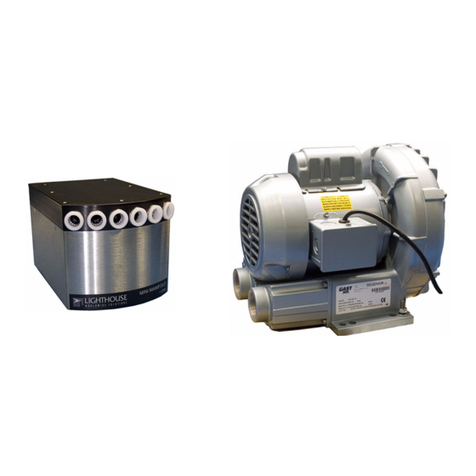
Lighthouse
Lighthouse 1 CFM operating manual

Thermo Scientific
Thermo Scientific 48i instruction manual
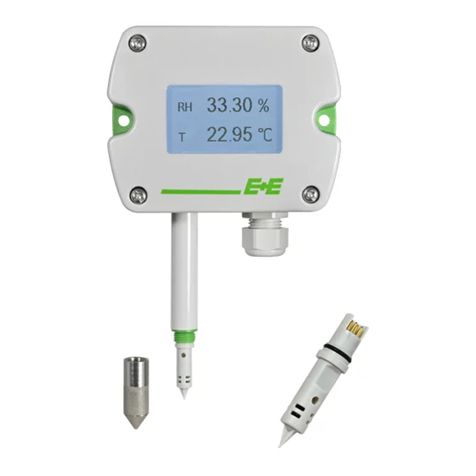
E+E Elektronik
E+E Elektronik EE212 user manual

Eilon Engineering
Eilon Engineering RON 2501 operating manual
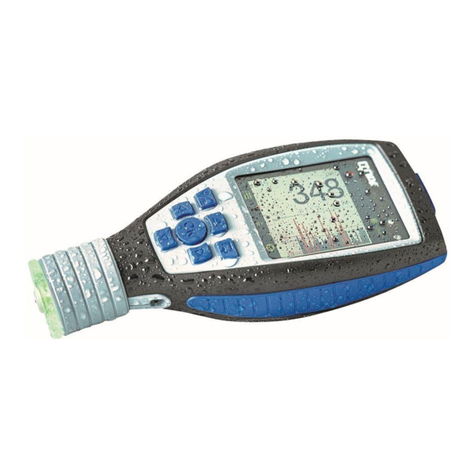
Automation Dr. Nix
Automation Dr. Nix QNix 9500 Series Operation manual
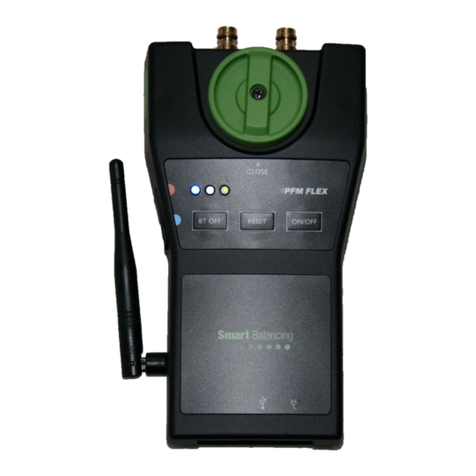
Smart Balancing
Smart Balancing PFM Flex 1 Operation manual
